August 25 - 31, 2019: Issue 418
Tram Memorabilia - Historic daylight run for sydney light rail begins 80 years after last tram to Narrabeen closed

The first daylight run of Sydney's Light Rail took place this week, signifying a historic moment in the history of New South Wales.
Premier Gladys Berejiklian and Minister for Transport Andrew Constance boarded the first tram to make the journey during the day and travelled from the Martin Place stop to the end of the line at Circular Quay.
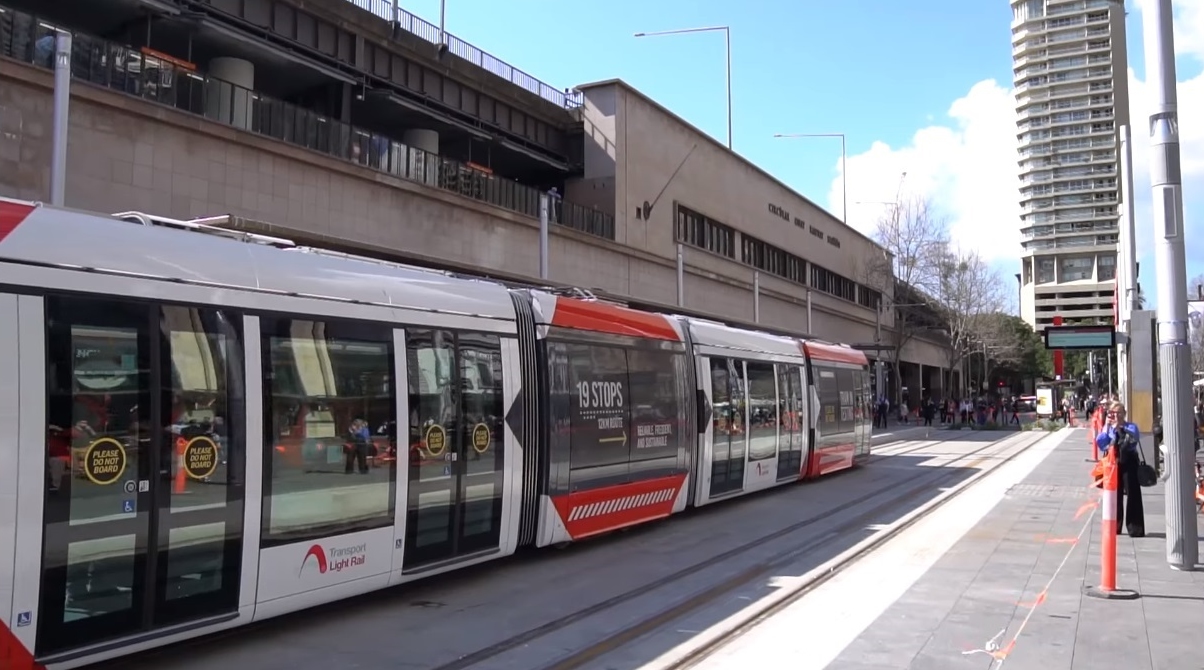
Tram moving to Circular Quay on Wednesday August 28th - Screenshot from Sydney Light Rail Facebook page
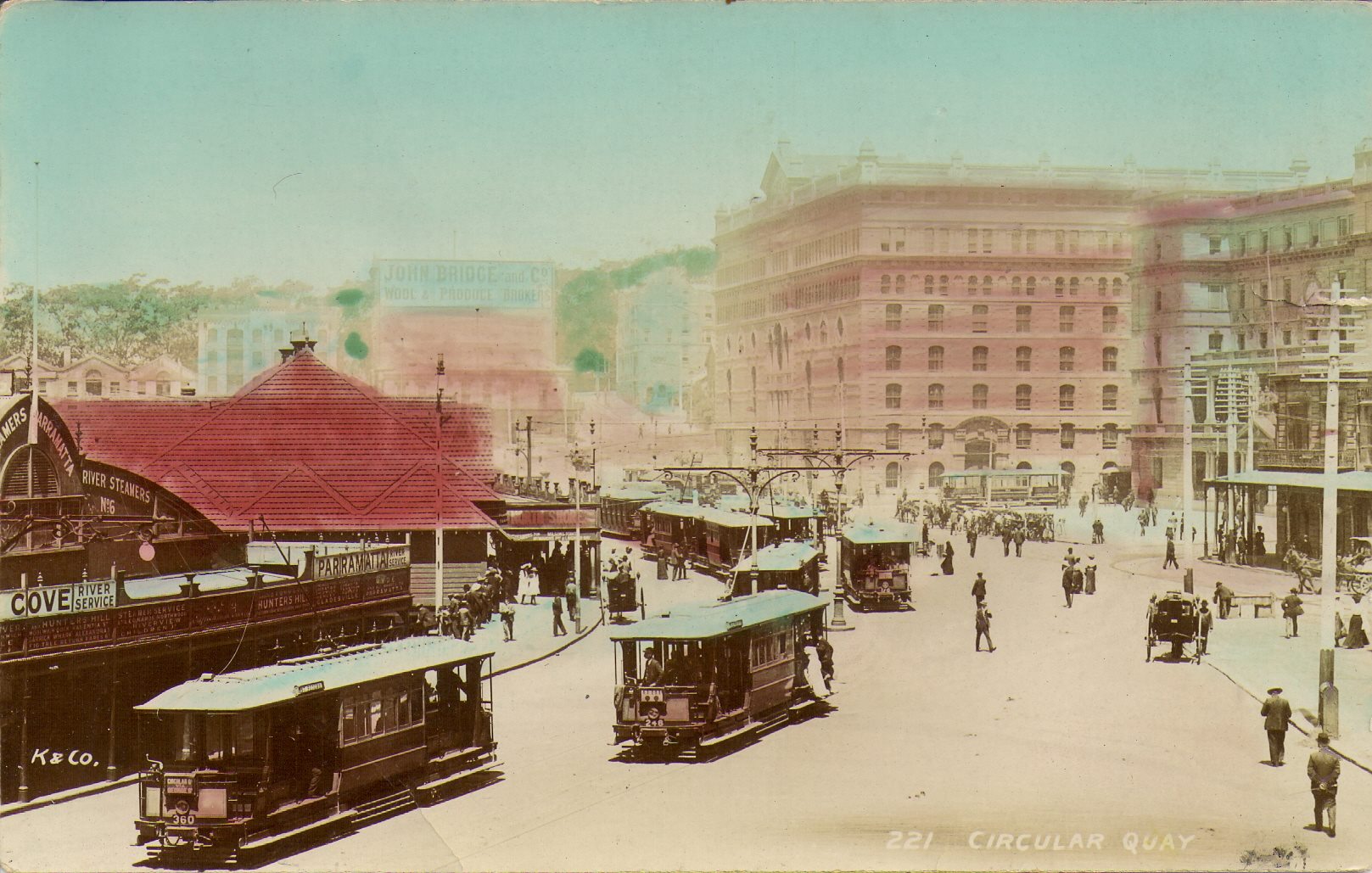
Trams at Circular Quay in 1906 - courtesy state Library of NSW
“This is an exciting day for Sydney with light rail vehicles making their way down the revitalised George Street,” Ms Berejiklian said this week.
“This is just the start of daytime testing along the length of the line and we can expect to see a lot more of it ahead of customer services starting before the end of the year.
“The new network will move up to 13,500 commuters an hour during peak time, replacing the conga line of buses which used to sit in traffic on George Street.”
Mr Constance again reminded the community to be aware of the changed environment in the area as tram testing becomes more frequent.
“Now trams are in the busy CBD day and night everyone needs to be aware, remove your headphones, get off your phone and remember to look both ways before crossing the road”, Mr Constance said.
“We’re now on the home stretch of this project and in December, Sydney residents and its visitors will benefit from a better connected city and a transformed boulevard.”
The new trams will hold up to up to 450 passengers, the equivalent of up to nine standard buses. This means the new light rail network will have the initial capacity to move up to 13,500 commuters per hour during peak times (7am – 7pm).
This week's news are a reminder that it is over 60 years since trams last rolled through the streets of Sydney and 80 years since the last tram rolled out to Narrabeen on September 30th, 1939.
That night was marked not only by a full contingent of passengers and by those aboard grabbing anything they could as a memento, recognising that last trip was also historic.
Collecting Tram or any Transport Memorabilia has become a popular past time for many in recent decades. Everything from the destination rolls to tram tickets, the buttons off old uniforms, or coin trays, posters and postcards is sought and passes hands, some items for thousands of dollars.
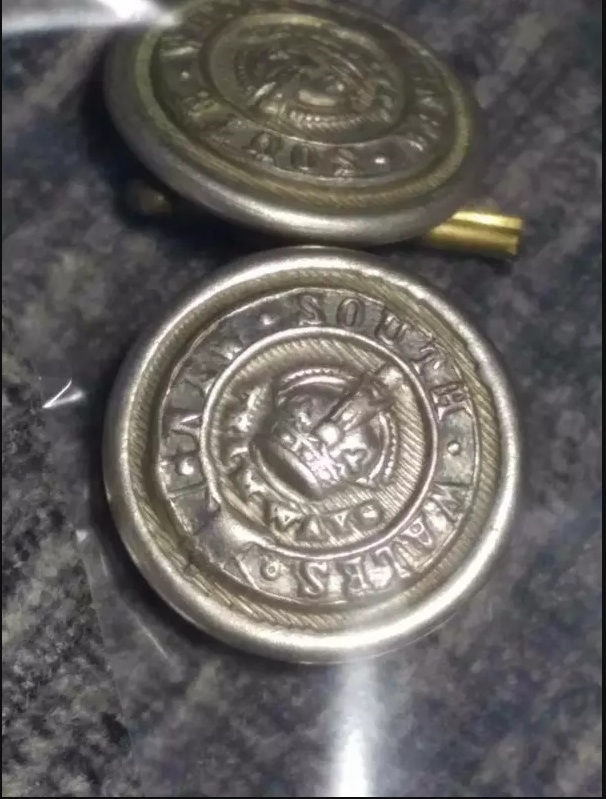
Vintage Silver NSW Tram Ways Buttons with Shank back & Split Pins.
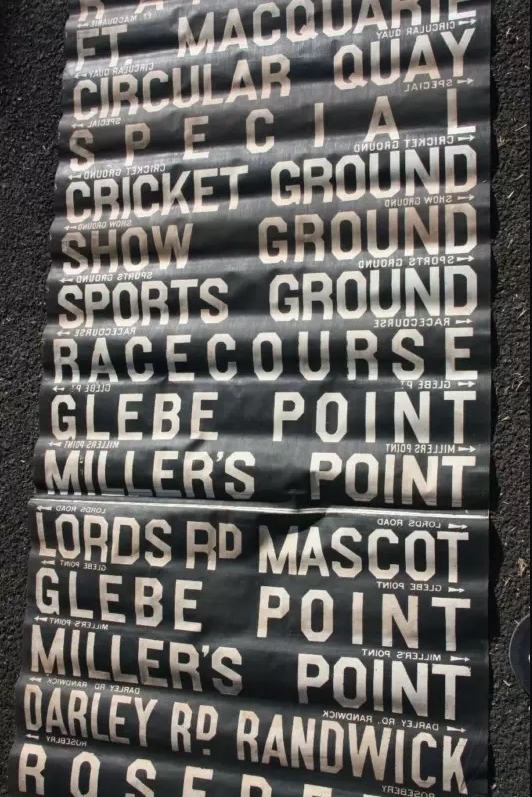
Tram Destination Roll – Sydney Eastern Suburbs. $3000.00 : Original canvas side destination roll from Sydney tram (Eastern Suburbs). White lettering on Black ink background. 790mm wide x 5700mm long (approx. 32”x228”) - seen on Ebay
Our museums are also the repository of this historic materials while one of the favourites of many is the Sydney Tram Museum, not least because of the trams that once ran as far as Narrabeen.
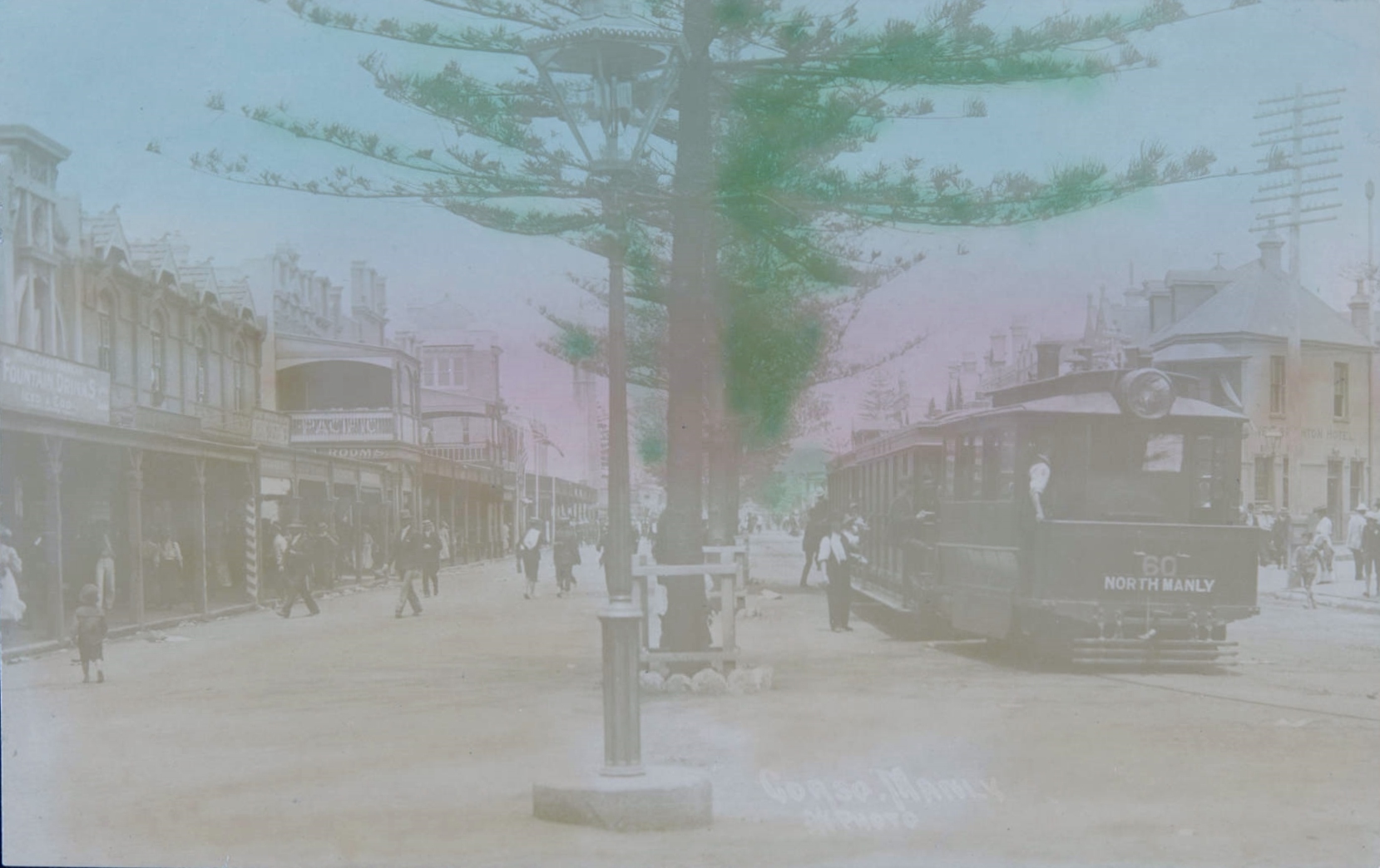
CORSO. MANLY.
Object information: A postcard featuring a coloured sepia photograph of a street scene with people, trams, trees and buildings. Handwritten text on the front of the postcard describes the photograph as 'CORSO. MANLY'. The postcard is unused. Shows Tram with 'North Manly'. from and courtesy Josef Lebovic Gallery collection no. 1 Apply Josef Lebovic Gallery collection no. 1 , National Museum of Australia
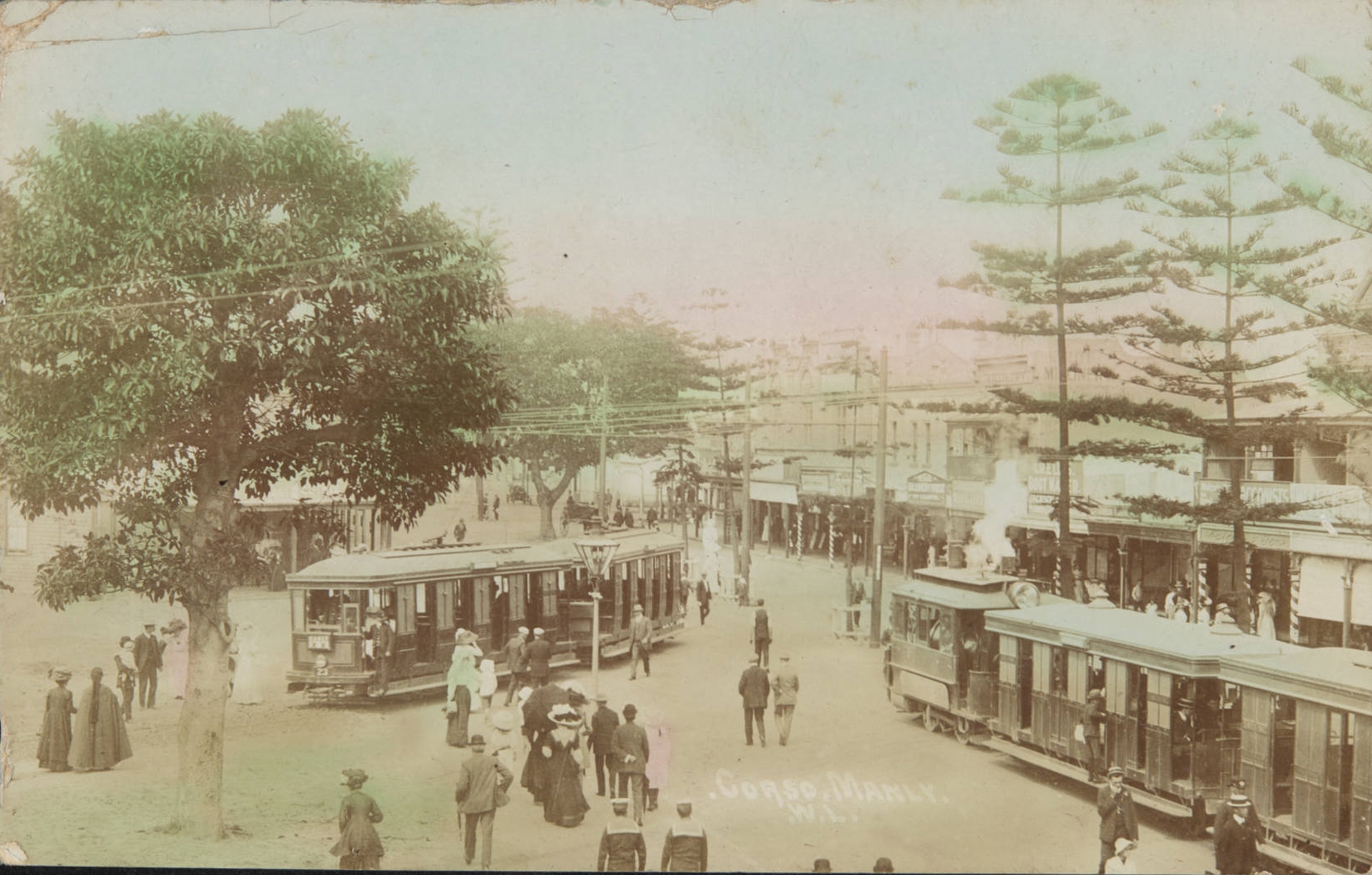
CORSO. MANLY. Object information: A postcard featuring a coloured sepia photograph of a street scene with people, trams and buildings. Handwritten text on the front of the postcard describes the photograph as 'CORSO. MANLY. W.L.'. Handwritten text on the back of the postcard begins 'Dear E & J...'. July 14/13 - from and courtesy Josef Lebovic Gallery collection no. 1 Apply Josef Lebovic Gallery collection no. 1 , National Museum of Australia
What seems to be scarce is actual Narrabeen Tram Memorabilia - although there must be some, somewhere. According to the article that runs below reporting on the last run from Manly to Narrabeen, the posters that once featured on them became hot property on that last run.
On September 30th, 1939:
300 farewell last, MANLY TRAM
LAST tram ever to leave Narrabeen dragged a pair of kerosene tins after it on Saturday night. —
Two boys had tied them on while a crowd of girls souvenired posters from the advertisement racks. Seventy red buses took over all Manly tram runs yesterday morning. Tram services were started to Manly 36 years ago.
On Footboards
Crowds at Manly wharf mobbed the last Spit and Harbord trams. Policemen rode on the footboards Iike gold-escorts. On its way to the depot 300 men and women, climbed into The Spit tram and took every, electric light globe. It poked Its tired nose into the shed with a tram-men's wreath hanging over the headlight. Earlier; Sub-inspector O Dwyer, dressed as a deacon, had conducted a party of tram-men to a Manly funeral parlor. They were photographed there, mourning those about to die.
The tram which made the last run from Manly wharf to Narrabeen and back was packed. A militia soldier took off his boots and lost them to the crush; A solid citizen said: "Struthl! They don't expect us to pay for this, do they?" He gave the conductor all he had; a tote ticket and a penny,
27 Years
"Twenty-seven years I've been on this run." Driver Bill McLintock told the Daily News. "I'm a bit sad about leaving. These old trams were like a home to me, "I suppose buses are all right.. "As a matter of fact, I'm learning At Dee Why a shopkeeper handed him a parcel wrapped to paper. -"Little farewell present," said the driver. "You get to know everybody in 27 years. ""Worst thing about this line was the smell of "prawns." , Driver McLintock and his conductor, H. Wright are going to North Sydney tram depot. So are the Manly Inspector,- Mr. A. Bond, and most of his drivers. The conductors will work on the Manly buses. Soon the Narrabeen, Harbord and Spit trams will be used on the North Shore lines. 300 FAREWELL LAST MANLY TRAM (1939, October 2). Daily News (Sydney, NSW : 1938 - 1940), p. 2. Retrieved from http://nla.gov.au/nla.news-article236338598
The Last Run
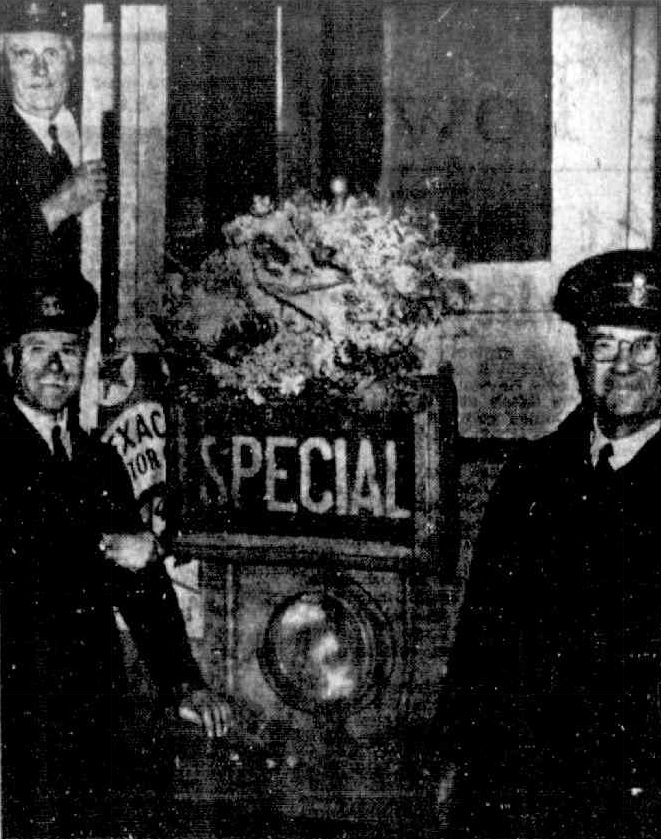
The Manly-Narrabeen tram on, its last run early on Sunday morning. Driver William McLintock (top), conductor E. Wright (left) and Inspector. A. Bond smile at the ''wreath" above the destination board. All Manly and Warringah trams ceased to run on Saturday night. (Story page 2.) The Last Run (1939, October 2). Daily News (Sydney, NSW : 1938 - 1940), p. 5. Retrieved from http://nla.gov.au/nla.news-article236338674
The 'advertisements' running in 1939, alike earlier 'art' versions placed in newspapers for Pears soap for example, were colourful stylised posters sized to fit in those spaces above the heads of passengers.
The Sydney Tram system, if counted from its first foray in 1861 until its last run on February 25th 1961, produced 100 years of a transport system that stretched across the Sydney basin was the largest in Australia during its heyday, the second largest in the Commonwealth of Nations (after London), and one of the largest in the world. The network ran around 1,600 cars in service at any one time at its peak during the 1930s , with patronage peaking in 1945 at 405 million passenger journeys, while its maximum street trackage totalled 291 km (181 miles) in 1923.
Luckily, thanks to a shire clerk buying a couple of the earlier horse drawn trams, we still have one of these thanks to the Sydney Tram Museum and the Powerhouse Museum:

Above: Horsedrawn Manly tram, 1894, Made by Randwick Tramway Workshop in Randwick, New South Wales, 1894. Photo courtesy Powerhouse Museum, Sydney
The first trams used in Sydney were pulled by horses, and this is the only known survivor of the tramcars that were used on horsedrawn services.. A horse could pull a greater load along a smooth rail than over a rough road, due to the rail’s lower rolling resistance. A horsedrawn tram also offered passengers a more comfortable ride than a horsedrawn omnibus, a contemporary form of public transport that plied the streets of Australia’s colonial cities.
The first horse trams in Sydney operated from 22 December 1861 along Pitt Street to link the ferries and ships at Circular Quay with the main railway terminus at the then Redfern Station, which was located near Devonshire Street. Pulled by four horses, they held 30 passengers inside and another 30 on the roof. This service was discontinued five years later following the death of a prominent citizen in a tramway accident.
From 1861 to the 1960s, Sydney’s public transport included a series of tram systems, and each was initially embraced and ultimately rejected by administrators and local commuters. These systems were defined by the source of tractive power: horse, steam, cable and electric. As the city grew, new ways were constantly sought to adapt and integrate this transport technology to meet the needs of the prosperous and rapidly expanding harbourside city.
This tram dates from the second phase of horse trams in Sydney, when they ran in Newtown from 1894 to 1898 and Manly from 1903 until 1907. Both these services were introduced as temporary, more economical replacements for poorly patronised steam-operated services.
From 17 December 1894, two horse tramcars operated between Newtown and St Peters Station. The two tramcars, each drawn by one horse, carried the numbers 198 and 199 (the tramcar now in the Museum’s collection) in the steam tram trailer car fleet. They were housed in the former Newtown steam tram shed.
The trailer cars had been completed at the Randwick Tramway Workshops of the NSW Government Railways in July 1894 to operate on the Newtown-St Peters steam tram route but, due to light patronage of the route, the decision was made to change to a less costly horsedrawn service, which was maintained until 1 July 1898.
These cars were similar to the North Sydney cable car trailers in design, with end-loading platforms; however, they had five rather than six side windows, were only 4880mm (16 feet) long and were mounted on four 762mm (30 inch) diameter pressed steel wheels. During 1901, the two cars were reallocated to the electric tramcar fleet, refitted with 610mm (24 inch) cast steel wheels and renumbered 293 and 292 respectively.
Cars 293 and 292 remained at Manly Tram Depot and were written off the books in February 1913. Archival records show that they were sold to a Mr P Carew of Brookvale for five pounds each. Car 292 was converted to living quarters and on 1 March 1953, it was donated to the Museum by Manly Municipal Council and subsequently restored.
BROOKVALE TRAM.
Last week Mr. Conyers, of the Public Works Department, measured up the second lot of stone from French's Forest now lying on the Pittwater-road, between North Manly and Brooklyn. The quantity was 500 cubic yards, for which Mr. Carew, the shire clerk, received a cheque for £150 this week from the department. This cheque (the second) he has passed on to the contractors, Messrs. G. Riddle and H. Thew, whose first cheque, for 585 cubic yards, amounted to £174.
Nearly 1100yds from French's Forest, out of 4000 required for the tramway, have now been got out and paid for. The 1200yds got out of the quarry at Brookvale by the first contractor, for which the department paid about £250, will make up the full total of 5000yds required for the tramway. The approved stone, under the new contract, is now coming out of French's Forest very fast. BROOKVALE TRAM. (1909, April 22). The Sydney Morning Herald (NSW : 1842 - 1954), p. 4. Retrieved from http://nla.gov.au/nla.news-article15052498
The story of trams in Sydney began over half a century before the first pulled into the Narrabeen terminus:
TOWN AND COUNTRY NEWS.
OPENING OF THE PITT-STREET TRAM-WAY.
The tramway along Pitt-street was permanently opened for traffic on Monday. According to the announcement, one of the cars, drawn by four horses, was taken along the line soon after six o'clock on Mon-day morning, and at 6.25 it started from the Circular Quay to take passengers for the 6.45 train from Red-fern; having stopped twice to take up passengers, it traversed the distance— a mile and three-quarters— in less than ten minutes. Upon the arrival of each of the ordinary trains at Redfern, the car left the terminus crowded with passengers, who were put down at whatever part of Pitt-street they required ; passengers also waited at different places places along the street to be conveyed by the return trip of the car. The novelty of the sight attracted numerous groups— in some places large crowds— of persons to the pavement to watch the progress of the strange looking conveyance, which excited an unusual degree of curiosity and interest. The car is about twice the length of an ordinary omnibus ; it is entered at both ends from landings which are open on both sides; the floors of these being low, they are easily, ascended from the street. The vehicle is proportionately wide, and is constructed to seat thirty passengers inside and the same number on the roof, and will accommodate about the same number standing. Convenient iron steps for reaching the roof are provided at either end.
The outside of the car has rather a gayish appearance, the body being a lively yellow; in the centre a lion, and an eagle taking the place of a unicorn being represented, with the motto, "Unity is the strength of Nations." The names of the two cars are respectively "Old England," and "Young Australia." There is a driving box at either end of the car, and on arriving at the Circular Quay the driver shifts his place and the pole, and the horses are transferred.
So far as the transit of the cars was concerned, the experiment of the tramway has hitherto proved thoroughly successful. No perceptible inconvenience occurred in consequence either of the sharp curves near the terminus, or of the occasional unevenness of the line. The motion of the car is extremely easy and comfortable, and passengers accustomed to the rattling and jolting of the 'buses, will appreciate the means now afforded of entirely escaping from those annoyances. This obvious recommendation attracted yesterday to the car not only the ordinary Pitt-street passengers, but also many who stepped into it tor the sake of the ride. Although the complement of the car is only sixty passengers, on one trip there were no less than seventy-five per-sons in it, without the least appearance of overcrowding.
The sum of threepence is charged for the journey, journey, being a penny less than the previous omni-bus fare. There are several further arrangements requiring to be made to give complete efficiency to the Pitt-street tramway. It will be necessary to have a depot for produce and merchandise at the Circular Quay, where goods can he received for transmission to any station on the line ; and also to have the tramway carried round to the east side of the quay. The suggestion, too, in worthy of consideration, whether as a street railway the tramway might not with advantage be used, irrespective of the railway trains, for the conveyance of passengers to and from the opposite ends of the city, the superiority of this mode of transit being evidently appreciated by the public.
The passengers speak in high terms of the pleasantness of the mode of transit, the motion and vibration being scarcely perceptible, excepting when a stone happens to lie on the rails, which might be prevented by a very simple apparatus. The vehicle is very readily stopped, but as passengers can get in and out with ease and safety when it is proceeding at a slow pace, there will be no necessity for frequent stoppages. The scheme is generally acknowledged to be, so far, a success ; and, many who, up to the opening of the line, pronounced it on utter failure, are now either silent about it or have turned round and spoken approvingly. The public curiosity, excited by the steady progress of the immense gaudy car, continues unabated, crowds collecting at the street corners to see it pass.
The contract for the horsing is being very spiritedly carried out by Mr. Woods, who has provided for the work teams of fine powerful horses, and who is evidently determined to render the tram-way a success so far as the completeness of his appointments can conduce to it. The fact of the car conveying comfortably a hundred persons whose aggregate weight could not have been less than five tons — the weight of the car being two-and-a-half tons— proves at the same time the strength of the horses employed and the superiority of tramway locomotion over that of ordinary vehicles. A wooden building is being erected in the terminus yard to afford stabling for the horses ; it will have seven stalls and a harness-room. It is considered very desirable that the proposed arrangements for goods traffic on the line should be at once and vigorously proceeded with, in order that the full advantages of the tramway may be realised, and the success of the experiment thereby established.
TOWN AND COUNTRY NEWS. (1861, December 28 - Saturday). Sydney Mail (NSW : 1860 - 1871), p. 2. Retrieved from http://nla.gov.au/nla.news-article166692421
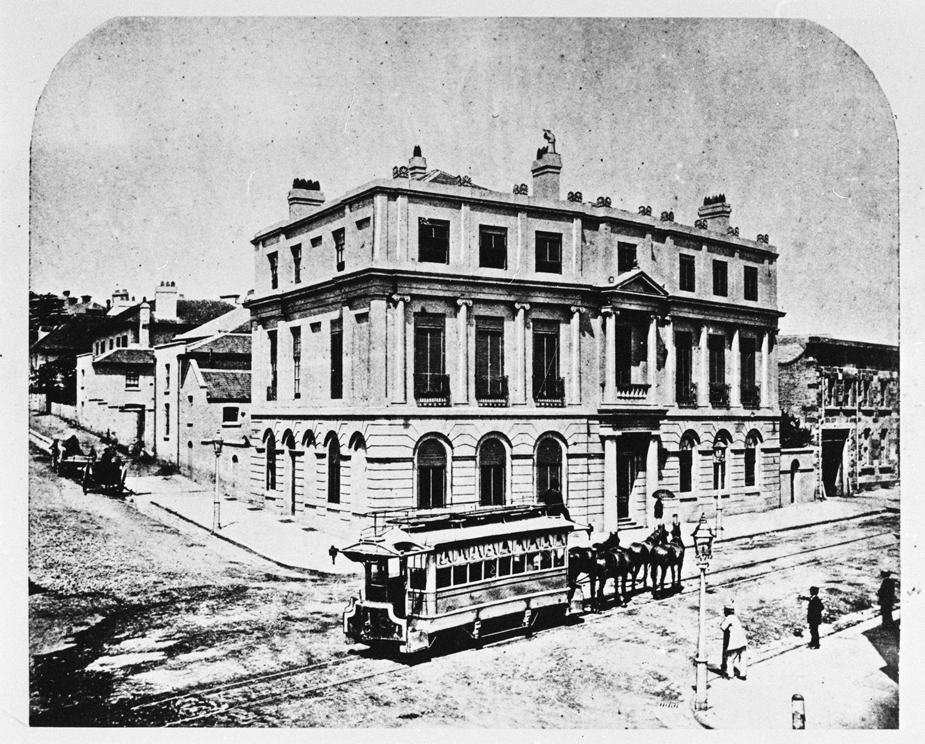
Horse-drawn tram outside the Union Bank on the corner of Hunter and Pitt Streets circa 1865. Image courtesy National Archives of Australia [C4078, N7037]
The 1861 launched horse-drawn trams weren't popular - the protruding tracks damaged wagon wheels, rubbed the competing Horse Omnibus owners the wrong way and then a fatal accident involving the popular musician Isaac Nathan in 1864 – led to closure in 1866.
In 1879 a steam tramway was established in conjunction with the upcoming Sydney International Exhibition that was to be held in the Domain/Botanical Gardens area of Sydney. Originally planned by the government to be removed after the exhibition, the success of the steam tramway led to the system being expanded rapidly through the city and inner suburbs during the 1880's and 1890's.
Electrification of Sydney Trams started in 1898. The Sydney tram power supply system was built using New York City subway electrical equipment that was adapted for tram usage. A generating plant was installed at Ultimo and White Bay Power Stations. Most of the system had been converted by 1910. An exception was the privately owned Parramatta line built by Charles Edward Jeanneret in 1881 [Newport Marine village] to Redbank Wharf (Duck River) where the steam tram remained until 1943.
SYDNEY TRAM SYSTEM.
Conversion of Steam Trams.
In connection with the conversion of the Sydney tramlines, the additional machinery at the power house, Ultimo, is now ready, for operation, and the commissioners will, from next week, carry out the: conversion of the Balmain line, with others to follow. After the Balmain line, it is Intended to first convert the line to Waverley and Bondi. After Waverley It Is Intended to take in hand the conversion from steam to electric traction of the Crown-street, Coogee, and Botany lines; but it will be several months' before the whole work can be accomplished.
The additional plant makes a distinct advance. In regard to electrical equipment. In the earlier stages it was thought that the power house originally designed would have been sufficient to cope with the conversion of the steam " to the electrical working, but the tremendous development that has taken place, due very largely to the popular system of fares charged soon demonstrated that It- would be necessary to duplicate -the power, and the working of the Balmain line on Monday is practically the first result of the additional power which has been Installed. This afternoon there was an informal gathering of pressmen .and others, who viewed the new works, which are of magnificent proportions. The plant Is the latest development of electrical science, and the largest- of its kind south of the Equator. The additional plant now being brought In to service consists of 16' additional Babcock and Wilcox boilers of 250 h.p.- each, and three 1500 kilowatt alternators, driven by com pound AUIs engines. The boilers are designed for a working pressure of 1601b.,' and pro vision Is made for bringing the total number up to 60 boilers of this type, bringing the total capacity up to 24,000 horse power. The engine-room extension consists of an addition of 170ft. to the southern end of the old engine room; the extension providing for six main generating sets of 1500 kilouwatts each. An Important feature of the power-house Is the switchboard. There are now 338 cars in operation on the electric lines, and others are under construction. The motors employed are of the general electric and Westinghouse types, and Christensen compressed air brakes are Installed on all new ears. To accommodate the large number of cars, four large sheds are already in use at Ultimo, Newtown, Rushcutters Bay, and North Sydney, and two large sheds are being constructed at Waverley and Rozelle Bay. SYDNEY TRAM SYSTEM. (1902, August 9). The Australian Star (Sydney, NSW : 1887 - 1909), p. 4. Retrieved from http://nla.gov.au/nla.news-article228944739
On this side of Sydney Harbour residents had been clamouring for similar transport infrastructure, resulting in:
North Shore, Manly, and Pittwater Tramway and Railway Act of 1888: "An Act to authorise the construction of a Tramway from the northern terminus of the North Shore Cable Tramway to the Spit at Middle Harbour, and from the Spit aforesaid to Manly Village, and a Light Rail way thence to Pittwater, Broken Bay. [10th January, 1889.]" – authorised a private tramway from the end of the Milsons Point to Ridge Street cable tramway to Manly, and a light railway from Manly to Pittwater.
By the early 1890's the discussion of getting a tram to Narrabeen had been renewed and by the late 1890's a committee had formed:
MANLY-PITTWATER RAILWAY.
TO THE EDITOR OF THE HERALD.
Sir,—I am pleased to see that your correspondent, Mr. Robey, is endeavouring to revive the question of the construction of a line of railway or tramway from Manly Beach to Pittwater, and I agree with him that this is a case in which the new betterment
principle proposed to be introduced by Mr. Lyne might well be brought into operation. If the line be constructed under this condition, it is one which will give a handsome return upon the outlay from the day it commences running. It is an opportune time to direct attention to the matter, because the Manly Council have called tenders for the lease of the wharf, and if some of those who purpose tender-ing include in their offers a proposal to combine a line of tramway to Pittwater, to run in conjunction with the steamers, I feel sure the project will meet with the hearty support and co-operation of the whole district. A line constructed on the narrow gauge, with standard gauge carriages, which has been so successful in various parts of France and the Continent, could be laid down for £1500 per mile, and if a line of this description were run in conjunction with the steamers from Sydney, issuing through tickets for steamer and tram, the venture would be a highly remunerative one ; a large proportion of the excursionists who travel by the steamer would patronise the tram for the purpose of visiting the beautiful districts of Narrabeen and Newport which lie beyond, and which are now almost unknown to the residents of the city owing to the difficulty of getting there. It is to be hoped the
council in dealing with the tenders will give favour-able consideration to any proposal of this description which may be submitted to them, and if they accept an offer of the kind they will have the thanks of the residents for supporting an undertaking which will do more to advance the interests of the district than any other which could be placed before them.
I am, &c.,
JUDEX.
MANLY-PITTWATER RAILWAY. (1892, October 29). The Sydney Morning Herald (NSW : 1842 - 1954), p. 7. Retrieved from http://nla.gov.au/nla.news-article13884289
STEAM TRAM MOTORS.
In view of the intended conversion of the steam tramways to the electric system, the engineer-in-chief for railway construction has forwarded a report to the Minister for Works on the utilisation of steam tram motors in country districts for railway purposes, Mr. Dunne points out that in order to use the motors they will have to be provided with a water-tender. With water for 10 miles and coke for 20 miles the motors would draw 30 tons over a lino with ruling grade of 1 in 20. With fuel and water for 50 miles a load capacity of 22 tons, with a ruling grade of 1 in 50, the load possible would be 66 and 77 tons, 1 in 180 of 182 and 124 tons, and 1 in 100 of 169 and 161 tons. If the motors wore used for extra sharp curves special rolling stock would be necessary for goods traffic. The existing tram cars might be used for passengers. STEAM TRAM MOTORS. (1896, November 14). The Australian Star (Sydney, NSW : 1887 - 1909), p. 5. Retrieved from http://nla.gov.au/nla.news-article227512465
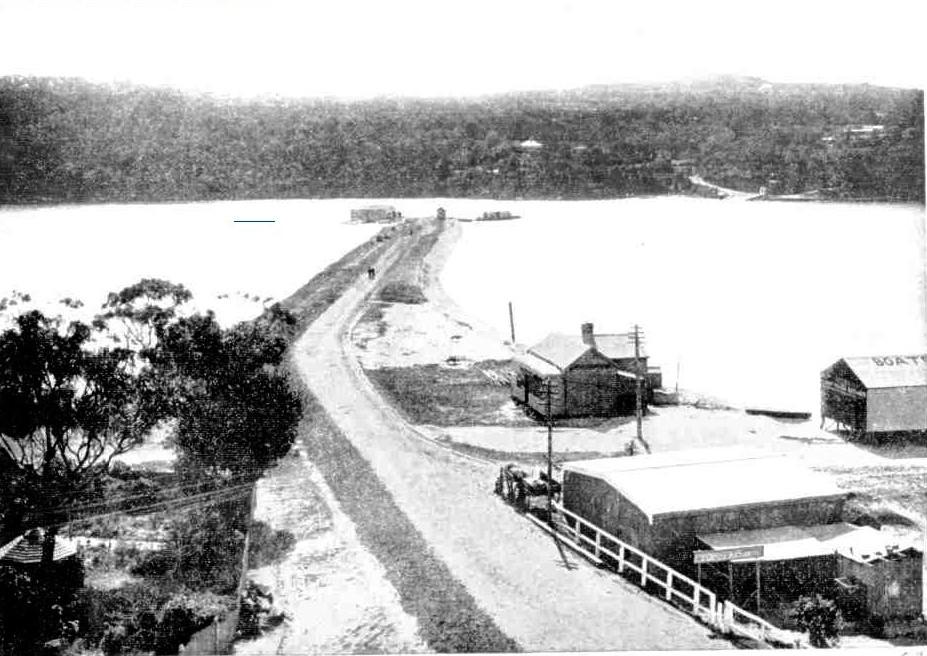
THE SPIT, MIDDLE HARBOUR, TERMINUS OF THE LINE.
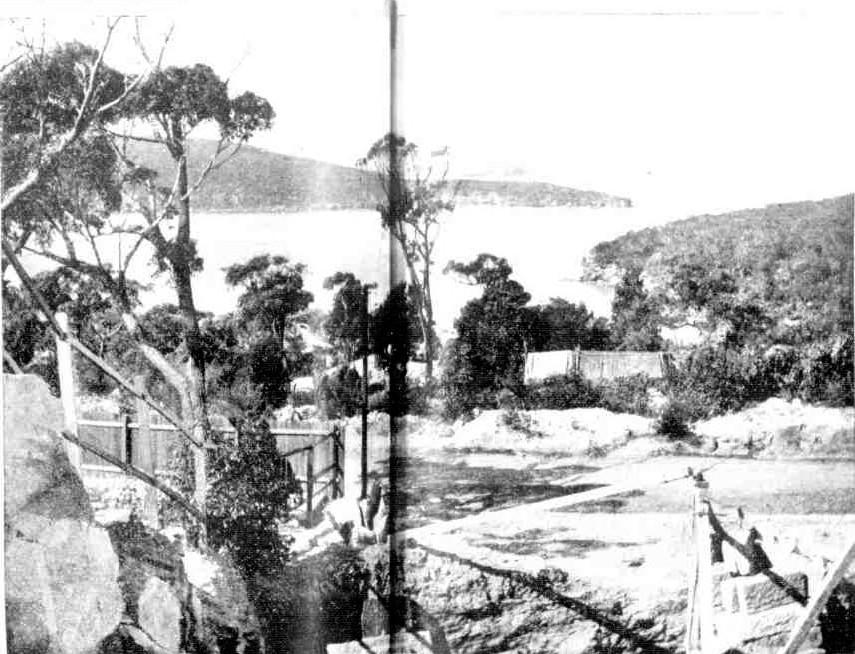
ON THE SPIT TRAM ROUTE— VIEW OF MIDDLE HARBOUR.
NORTH HEAD AS SEEN FROM HEIGHTS MILITARY-ROAD.
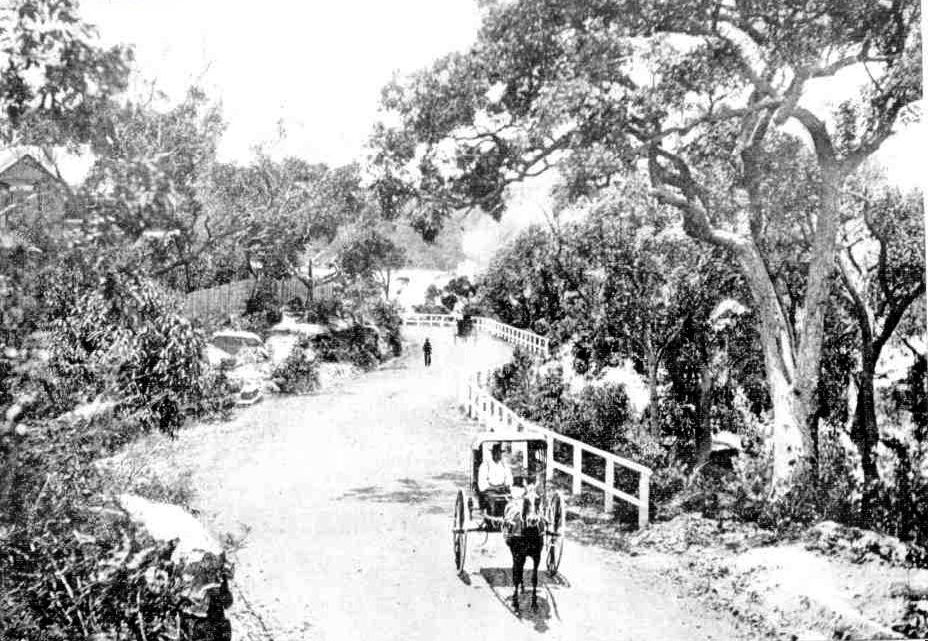
VIEW ON THE SPIT-ROAD -MIDDLE HARBOUR TRAM EXTENSION.
THE TRAM EXTENSIONS TO MIDDLE HARBOUR AND WATSON'S BAY. (1900, September 1). The Sydney Mail and New South Wales Advertiser (NSW : 1871 - 1912), p. 510. Retrieved from http://nla.gov.au/nla.news-article163693858
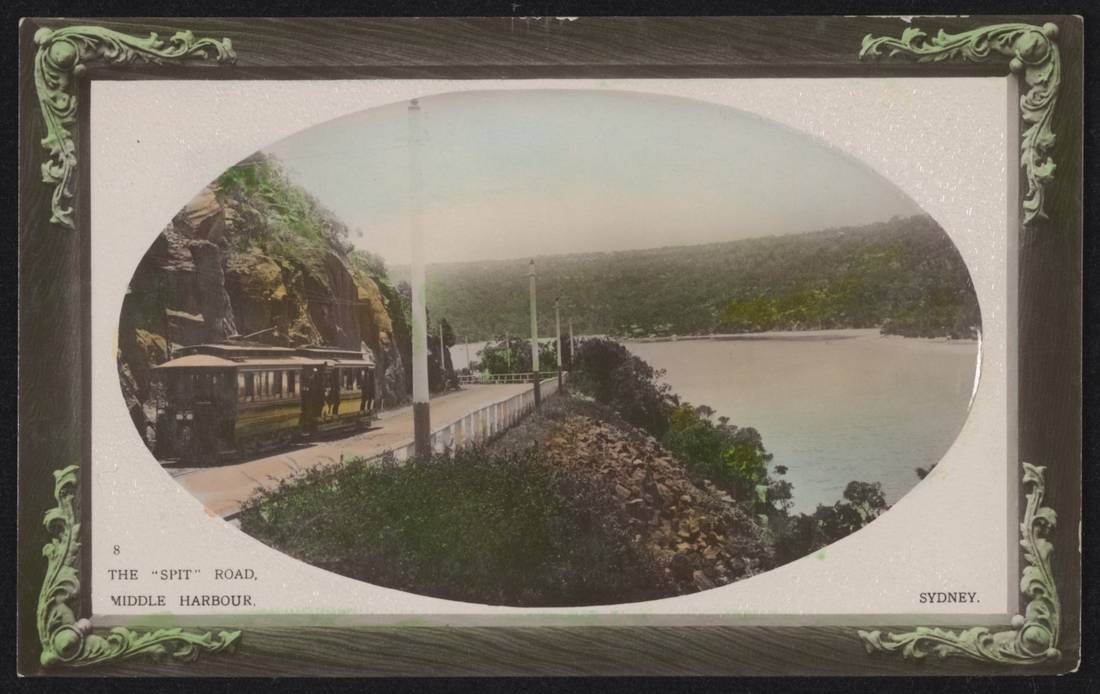
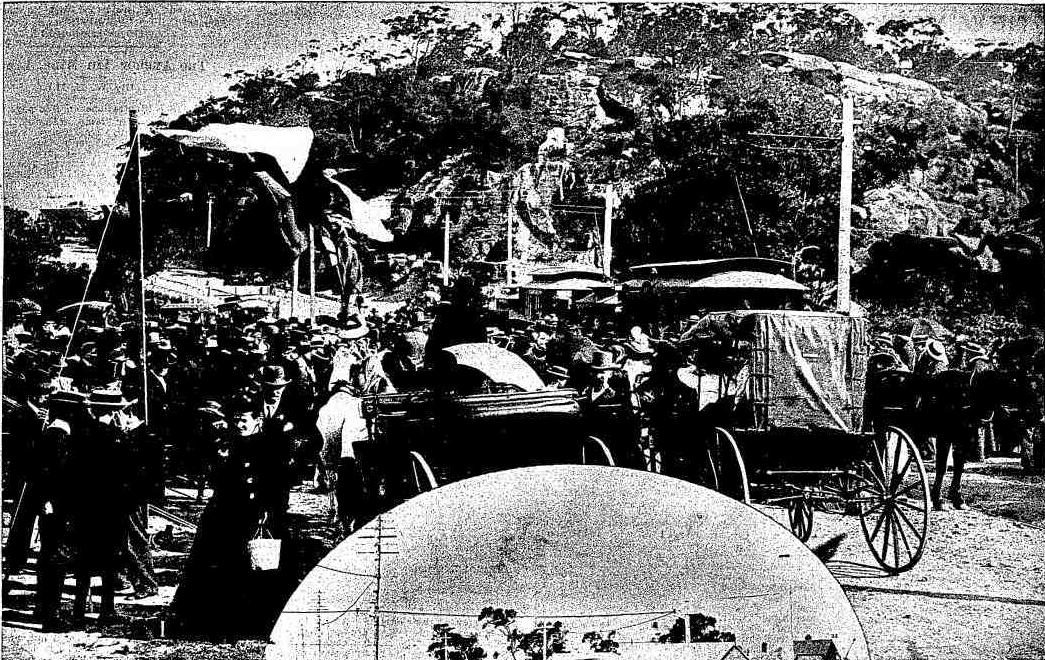
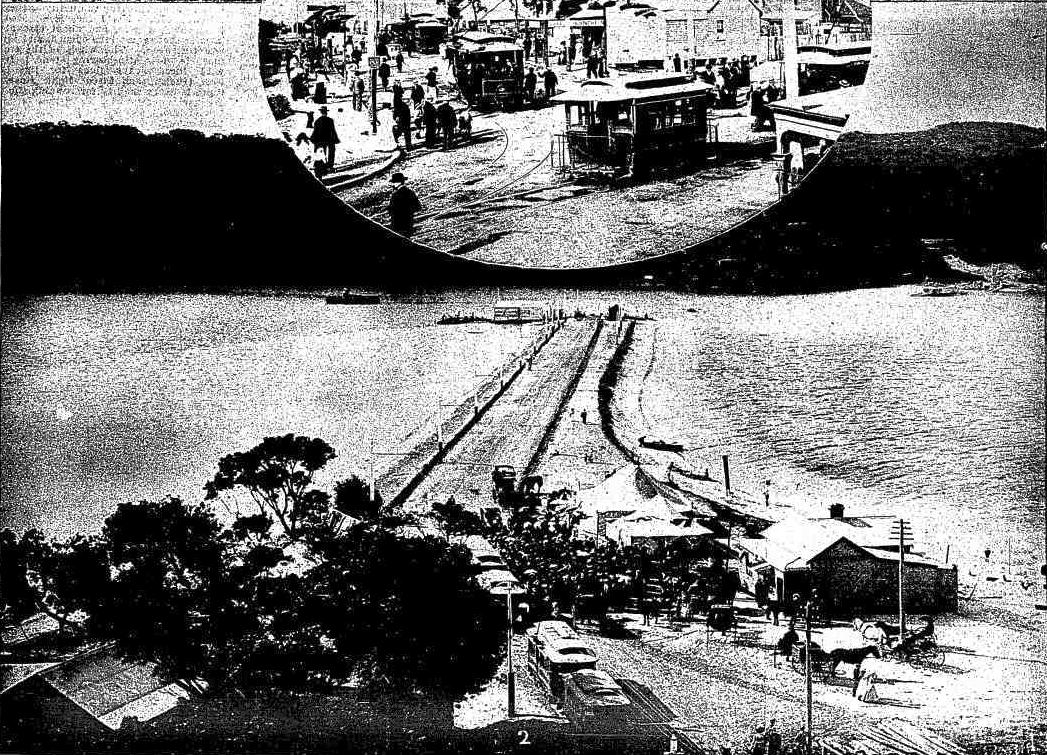
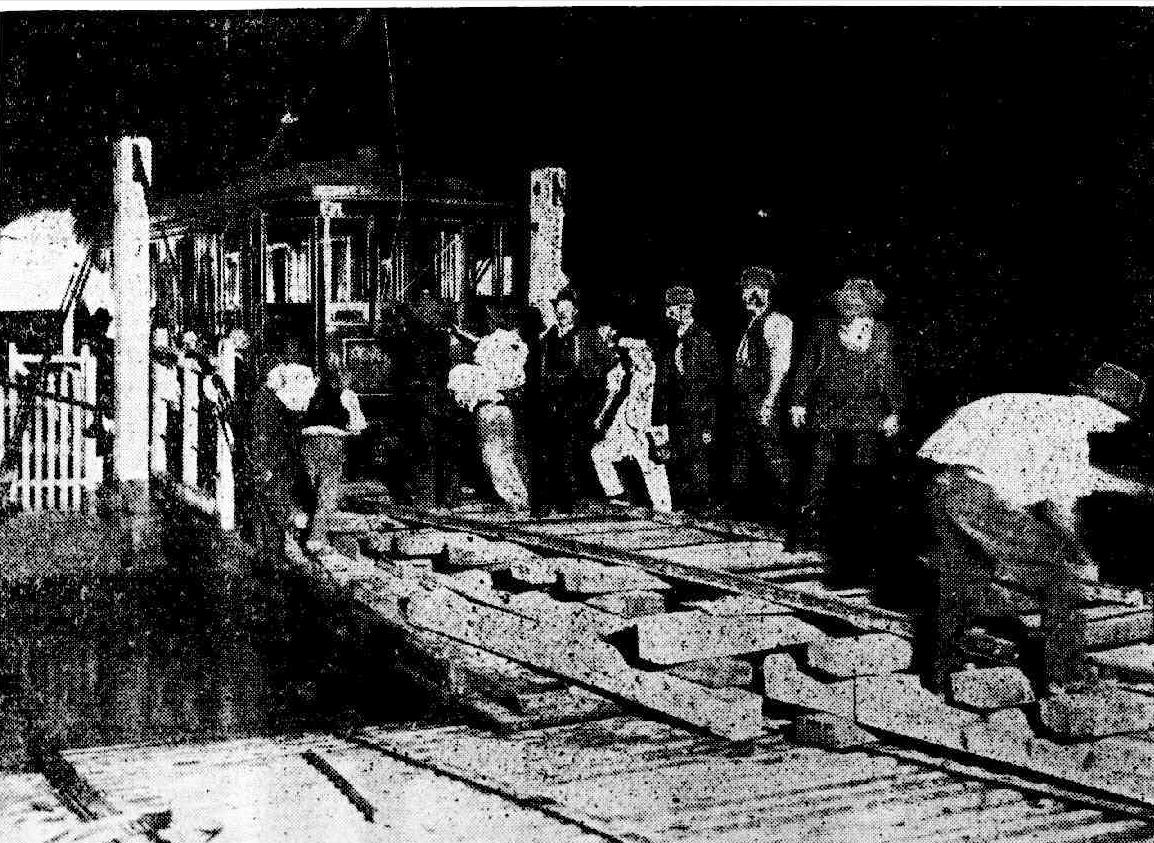
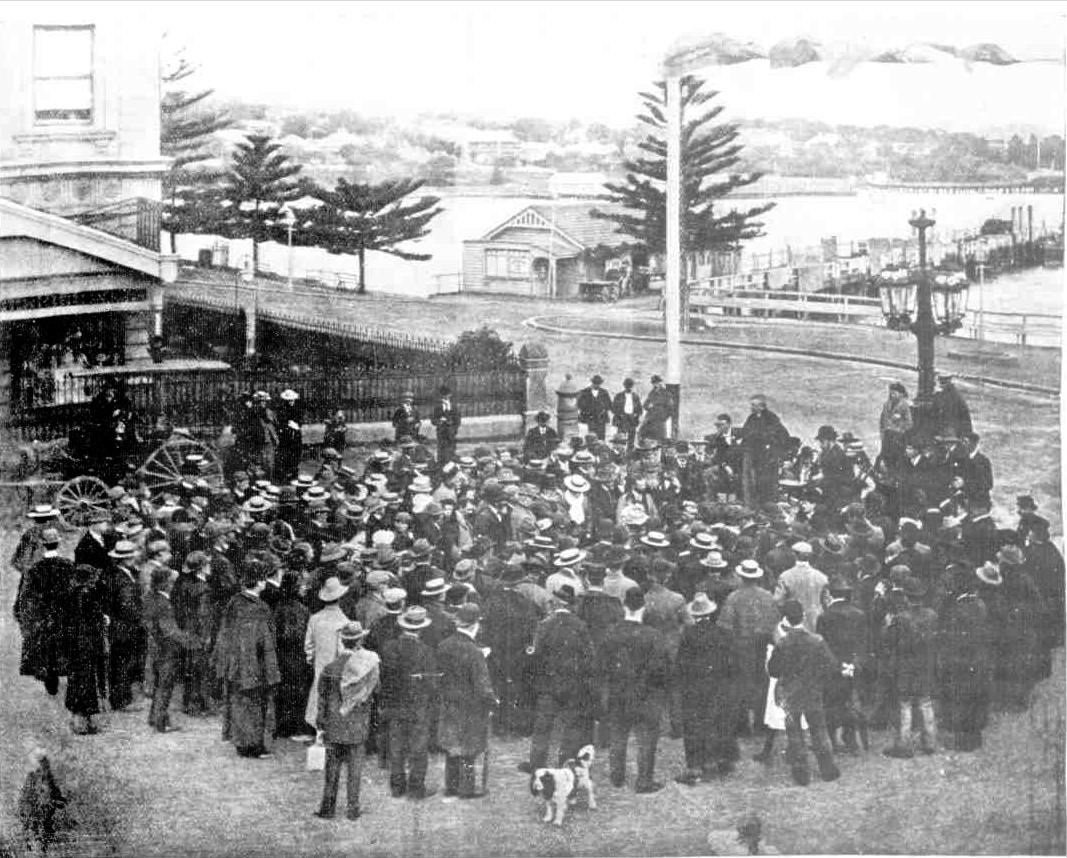
Commenced with great optimism, what had happened up the road would also recur at Manly:
THE SPIT TRAM.
MR. O'SULLIVAN MISTAKEN.
Mr. O'Sullivan surprised the Manly tram deputation on Thursday by stating that the line to the Spit was a profitable undertaking, and paid well. The deputation was very glad to hear this, as rumors to the contrary, the deputation said were rife. On inquiry to the Railway Commissioners yesterday as to the facts of the case, An 'Evening News' representative was informed that the Minister for Works was laboring under a misapprehension. They did not know where he got his information from, but the unfortunate fact was that the Spit line was now being worked at a considerable loss, and that even during the holiday and Commonwealth traffic it quite failed to pay its way. THE SPIT TRAM. (1901, August 10). Evening News (Sydney, NSW : 1869 - 1931), p. 6. Retrieved from http://nla.gov.au/nla.news-article114030882
The Manly tram, running from Curl Curl Lagoon (Manly end) to Manly, had its first day of public operation on Saturday 14th of February 1903, steam motor 41 operated the service hauling a single trailer, except between 3-04pm and 10-15pm when a second car had to be attached to cope with the heavy traffic. Some 2910 fares were collected on that first day yielding £12-2s-6d.
K. McCarthy, in The Manly Tramways - N.S.W. 1903-1939- A. 1903-1907 The Steam and Horse Tramway Era. (Trolley Wire, October 1979) states:
During that day paper bags of sand were thrown at the trams, but the police were called to stop this practice.
The Manly Depot staff at this stage were attached to Fort Macquarie Depot. Ticket Examiner Moore was originally destined to be in charge of the undertaking but he declined the job and Examiner Stuart Smith was appointed instead on 5 February 1903. Tickets bearing the depot code "MY" were issued twice each week from Fort Macquarie Depot. As the short journey only amounted to one fare section the following tickets were issued:-
Adult "down" journey - Id. 1st section pink.
Adult "up" journey - Id. 2nd section white.
Child journey - Id. brown.
During June 1903 the Tramway Department reached the decision that extreme economy of operation was required on the Manly tramway. An answer emerged in the adoption of horse operation to replace steam traction.
During 1901 two horse cars were fitted with 24 inch wheels, renumbered 293 and 292 respectively in the new electric tram roster and employed as electric trailer cars. These two vehicles returned to horse operation for the Manly Tramway. In a letter dated 26 June 1903, Electrical Engineer Brain informed Traffic Superintendent Kneeshaw that if these trams retained their smaller 24 inch diameter wheels at Manly, they could be available for horse working in ten days at a preparation cost of £11-2-0 per car. If 30 inch wheels had to be refitted the preparation costs would amount to £22-5-0 per vehicle and they would not be available for traffic for another three weeks. In addition the open point mechanisms in the Manly Depot yard had to be planked to prevent the horse from tripping.
The tram drawn by a horse was ridiculed in the papers of the day:
THE MANLY TRAMWAY.
The Manly tram, which is run by horse-power in its most primitive form, namely, by attaching a horse to the front of the car, cost the country, Mr. O'Sullivan states. £10,538, or, excluding the land. £10.428. This amount the Minister says, includes the erection of a large engine shed and fittings. He does not indicate in what way the erection of an engine shed assists the running of a horse-drawn tram, and he omits any reference to stable accommodation. The figures quoted were given In the Legislative Assembly in answer to a question by Mr. Fallick, as was also the fact that the tram shed cost £2821, and "would serve for present and future tramways near Manly, including the extension, to the Spit." Questioned as to the cost of the land for the sheds, the Minister explained that that matter "had not yet been altogether fixed." THE MANLY TRAMWAY. (1903, July 31). The Daily Telegraph (Sydney, NSW : 1883 - 1930), p. 4. Retrieved from http://nla.gov.au/nla.news-article237555022
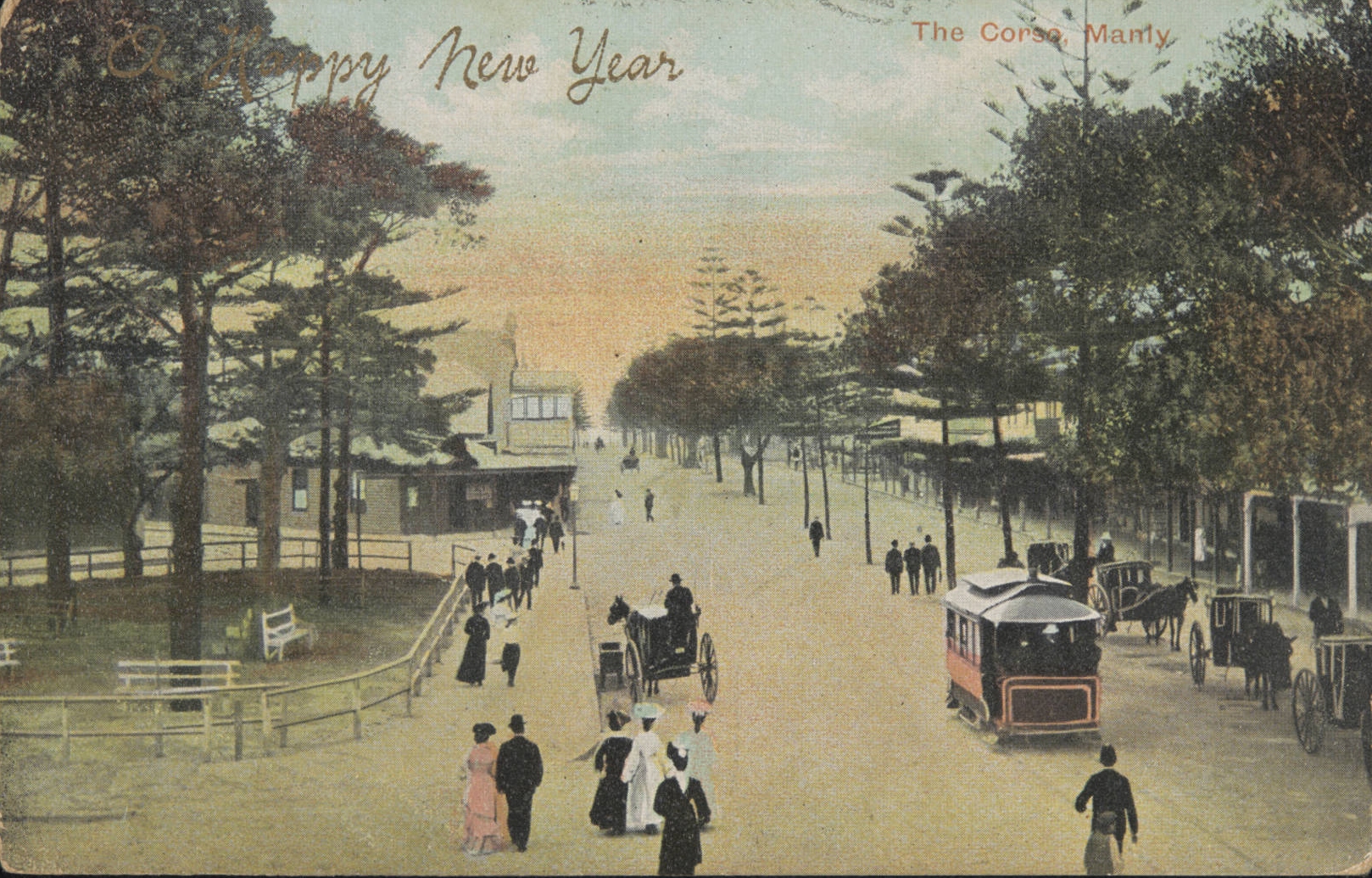
Manly horse-drawn tram at right - courtesy National Museum of Australia, postcard from Joseph Lebovic collection No. 1
M A N L Y S P R A Y .
August 6th, 1903.
The Manly to Curl Curl tram is now the source of much amusement to residents and visitors. Instead of progressing it appears we are reverting to times half a century agoue, when the trains were drawn by horses, at the rate of about 4 miles an hour. This service is carried on by contract, and about the only good resulting from the change is that the expense is not quite so heavy on the Government. The car will accommodate about ten persons comfortably. '
Manlyites, who posses about as much humour as any other port ion of the community, declare that it only wants Sir John handling the ribbons and the 'Onerable Ted collecting the fares to complete the farce. The original intention was to continue the line to Newport, which was a very good idea, and a work which, had it been completed, would have been attractive and beneficial to the people and remunerative to the Government.
Speaking of trams reminds us that the Manly to Spit Tramway League held its annual meeting at the School of Arts recently, Mr. Quirk, M.L.A., presiding, the principal business being the election of officers for the coming year. Several members spoke on the rising necessity for and many advantages to be derived from the construction of such a line, both to residents of Manly and Mosman. MANLY SPRAY. (1903, August 8). The Mosman Mail (NSW : 1898 - 1906), p. 2. Retrieved from http://nla.gov.au/nla.news-article247006267
This is how it looked in and around that area 1903:
MANLY to CURL CURL.
VIEWS ALONG THE ROUTE AND AT THE TERMINUS.
The newest of Sydney's tram services began running on Saturday. It extends from the Manly wharfs to the Curl Curl Lagoon, running down the Corso and along the ocean beach— otherwise the Steyne — 1 mile 40 chains. Ultimately it is intended to extend the line to Pittwater. Steam trams are being utilised in the service.
.jpg?timestamp=1574879500132)
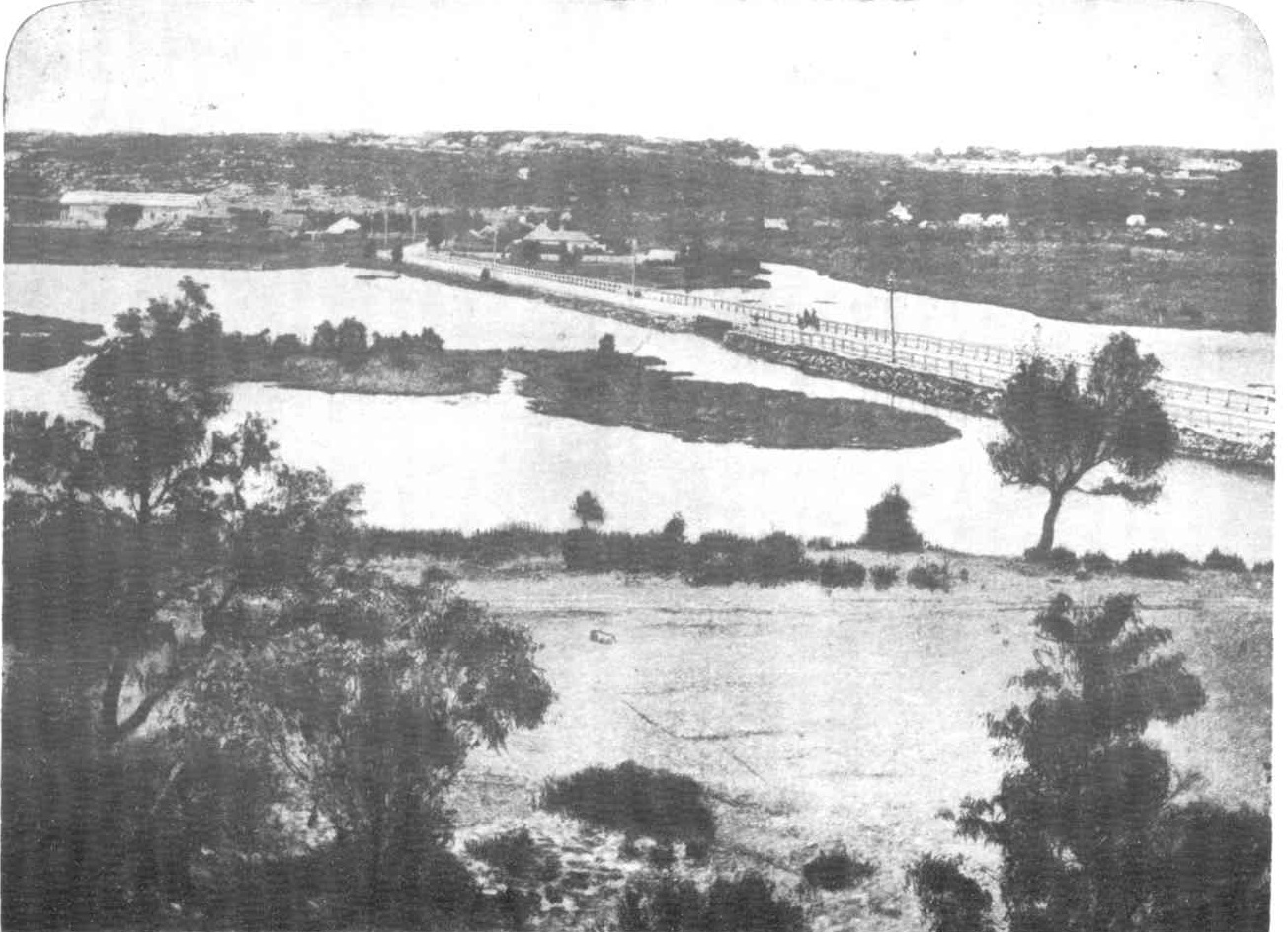
THE TRAM SHEDS AND TERMINUS AT CURL-CURL. From the other side of the Lagoon.
.jpg?timestamp=1574879535436)
CURL CURL END OF OCEAN BEACH.
.jpg?timestamp=1574879567792)
THE TRAM AT THE WHARFS.
.jpg?timestamp=1574879612469)
A DIP IN THE LAGOON.
.jpg?timestamp=1574879649080)
AT THE OCEAN BEACH. AT THE TERMINUS.
.jpg?timestamp=1574879703444)
LAGOON AND OCEAN BEACH FROM FRESHWATER HILL.
.jpg?timestamp=1574879752076)
WHERE THE LAGOON RUNS INTO THE OCEAN.
.jpg?timestamp=1574879780577)
ON THE CORSO.
MANLY to CURL CURL. (1903, February 18). The Sydney Mail and New South Wales Advertiser (NSW : 1871 - 1912), p. 416. Retrieved from http://nla.gov.au/nla.news-article163781666
The Manly tram, running from Curl Curl Lagoon (Manly end) to Manly, had its first day of public operation on Saturday 14th of February 1903, steam motor 41 operated the service hauling a single trailer, except between 3-04pm and 10-15pm when a second car had to be attached to cope with the heavy traffic. Some 2910 fares were collected on that first day yielding £12-2s-6d.
K. McCarthy, in The Manly Tramways - N.S.W. 1903-1939- A. 1903-1907 The Steam and Horse Tramway Era. (Trolley Wire, October 1979) states:
During that day paper bags of sand were thrown at the trams, but the police were called to stop this practice.
The Manly Depot staff at this stage were attached to Fort Macquarie Depot. Ticket Examiner Moore was originally destined to be in charge of the undertaking but he declined the job and Examiner Stuart Smith was appointed instead on 5 February 1903. Tickets bearing the depot code "MY" were issued twice each week from Fort Macquarie Depot. As the short journey only amounted to one fare section the following tickets were issued:-
Adult "down" journey - Id. 1st section pink.
Adult "up" journey - Id. 2nd section white.
Child journey - Id. brown.
During June 1903 the Tramway Department reached the decision that extreme economy of operation was required on the Manly tramway. An answer emerged in the adoption of horse operation to replace steam traction.
During 1901 two horse cars were fitted with 24 inch wheels, renumbered 293 and 292 respectively in the new electric tram roster and employed as electric trailer cars. These two vehicles returned to horse operation for the Manly Tramway. In a letter dated 26 June 1903, Electrical Engineer Brain informed Traffic Superintendent Kneeshaw that if these trams retained their smaller 24 inch diameter wheels at Manly, they could be available for horse working in ten days at a preparation cost of £11-2-0 per car. If 30 inch wheels had to be refitted the preparation costs would amount to £22-5-0 per vehicle and they would not be available for traffic for another three weeks. In addition the open point mechanisms in the Manly Depot yard had to be planked to prevent the horse from tripping.
The tram drawn by a horse, so soon after its previous tram had been opened, was ridiculed in the papers of the day:
THE MANLY TRAMWAY.
The Manly tram, which is run by horse-power in its most primitive form, namely, by attaching a horse to the front of the car, cost the country, Mr. O'Sullivan states. £10,538, or, excluding the land, £10.428. This amount the Minister says, includes the erection of a large engine-shed and fittings. He does not indicate in what way the erection of an engine-shed assists the running of a horse-drawn tram, and he omits any reference to stable accommodation. The figures quoted were given In the Legislative Assembly in answer to a question by Mr. Fallick, as was also the fact that the tramshed cost £2821, and "would serve for present and future tramways near Manly, including the extension, to the Spit." Questioned as to the cost of the land for the sheds, the Minister explained that that matter "had not yet been altogether fixed." THE MANLY TRAMWAY. (1903, July 31). The Daily Telegraph (Sydney, NSW : 1883 - 1930), p. 4. Retrieved from http://nla.gov.au/nla.news-article237555022
One of the sights of the service, at which thousands of persons have roared laughing, is the car drawn by the moke down at Manly. The spectacle of the old crock, with his tail half-mast and breathing flames of rage through his nostrils at the indignity, as he trots down the Corso with a grinning crowd in tow, seems to give visitors the impression that the Department has perpetrated it as a joke, to invest the sea-side village with a tinge of comic opera. 'What ho, Nell !' roared a leery cove to his tart, as they skipped up from the boat last Saturday afternoon ; ''hop inter ther chariot an' this blanky war-horse will take us fer a gallop out to Curl Curl ; blime, it will be orlright Then the troub whipped up, and the gallant steed pip-pipped, and the leery char with his bit of skirt clattered off to explore the wilds of Curl Curl by the blue lagoon. TRAM TROUBADOURS (1906, November 14). Sydney Sportsman (Surry Hills, NSW : 1900 - 1954), p. 5. Retrieved from http://nla.gov.au/nla.news-article167212436
The problem was one of finance and patronage. Although originally intentions were to run a tram line out to Newport and Bayview there was not enough to underwrite the venture and the lack of patronage at Manly did not help.
As one letter writer points out (the second shown below, who may possibly be George Brock of Brock's mansion who lost everything waiting on a tram line to come to Narrabeen and Bayview and Newport):
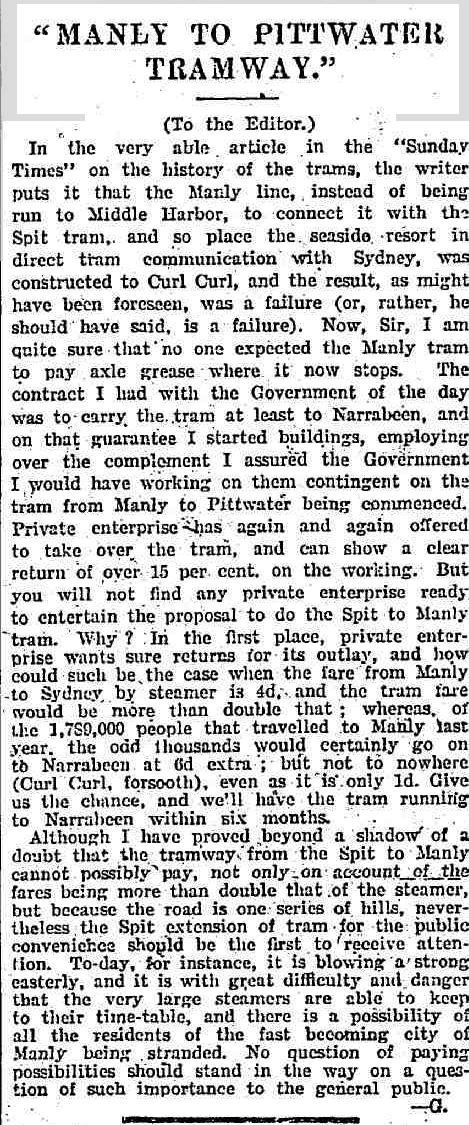
MANLY TO PlTTWATER TRAMWAY
(To the Editor)
In the very able, article in the 'Sunday Times' on the history of the trams, the writer puts it that the Manly line, instead of being run to Middle Harbor, to connect it with the Spit tram, and so place the seaside resort in direct tram communication with Sydney, was constructed to Curl Curl, and the result, as might have been foreseen, was a failure (or, rather, he should have said, is a failure).
Now, Sir, I am quite sure that no one expected the Manly tram to pay axle grease where it now stops. The contract I had with the Government of the day was to carry the tram at least to Narrabeen, and on that guarantee I started buildings, employing over the complement I assured the Government I would have working on them contingent on the tram from Manly to Pittwater being commenced. Private enterprise has again and again offered to take over the tram, and can show a clear return of over 15 per cent, on the working. But you will not find any private enterprise ready, to entertain the proposal to do the Spit to Manly 'tram. ' Why' ?' In the first place, private enterprise wants sure returns for its outlay, and how could such be the case when the fare from Manly to Sydney by steamer is 4d, and the tram fare would be more than double that; whereas, of the 3,789,000 people that travelled to Manly last year, the odd thousands would certainly go on 'to Narrabeen at 6d extra; but not to nowhere (Curl Curl, forsooth), even as it is only 1d. Give us the chance, and we'll have the tram running to Narrabeen within six months.
Although I have proved beyond a shadow of a doubt that the tramway from the Spit to Manly cannot possibly pay, not only on account of the fares being more than double that of the steamer, but because the road is one series of hills, nevertheless, the Spit extension of tram for the public convenience should be the first to receive attention. To-day, for instance, it is blowing a strong easterly, and it is with great difficulty and danger that the very large steamers are able to keep to their time-table, and there is a possibility of all the residents of the fast becoming city of Manly being stranded. No question of paying possibilities should stand in the way on a question of such importance to the general public. G. "MANLY TO PITTWATER TRAMWAY." (1905, April 9). Sunday Times (Sydney, NSW : 1895 - 1930), p. 2 (Magazine Section.). Retrieved from http://nla.gov.au/nla.news-article125863155
Another early land investor at Newport has an idea that seems less expensive:
OPENING UP THE LAND.
TO THE EDITOR.
Sir. — In your issue of February 27 you give the description and picture of a Shay Iocomotive as recommended by Mr. Deane to the Minister for Works, as suitable for the Dorrigo country.' I notice that with an engine of this nature it is stated the cost of the line could be considerably reduced, say, by figures given, to about £2090 per mile. Now, for a line of this nature to pay interest on capital let alone working expenses, It would require at least 150 tons per day. How many years will it be before the Dorrigo could give that amount, or anything like it?
I think for pioneer lines, such as that required for opening up new country, a far cheaper system can be found that will carry out all the requirements, and it would not be experimenting if the Caillet monorail was adopted. In Mexico there Is a continuous lino of 75 miles passing through rough country, which is callable of carrying 100 tons per day, which costs about £250 per mile. The single rail is laid on the ground over the natural surface.
The monorail is suitable for passengers or goods, the trucks carrying loads up to 5 tons, and the passenger carriages holding 12 or 16 people. In Brazil it is largely used for carrying logs to the sawmills, mining supplies to the various camps, besides passengers.
During the 10 years since it was first introduced, it has been one of the greatest of pioneer railways, and is being used in all parts of the world, England, Egypt, Mexico, Brazil, India, New Zealand, etc.
Knowing there is such a cheap and useful system for opening up new country, I suggest, before any of the Shay engines are obtained, a trial should be given of the Caillet monorail; so that everyone could see it and learn its value, I recommend a small line for goods and passengers be laid from Manly to Pittwater, when if it proves a success, it could be adopted in other places that could not pay the cost of a heavy line. A monorail line could be laid from Manly to Newport for £250 per mile; the carriages, to hold 16 passengers, would cost from £50 to £100 each, according to finish trucks, from £25 to £75; and by building this line the public would find that many districts could Increase their wealth by cheap feeders with the main railway line.
.— Yours, etc., OWEN BLACKET. March 8. OPENING UP THE LAND. (1906, March 9). The Daily Telegraph (Sydney, NSW : 1883 - 1930), p. 7. Retrieved from http://nla.gov.au/nla.news-article239435910
K. McCarthy, in The Manly Tramways - N.S.W. 1903-1939- A. 1903-1907 The Steam and Horse Tramway Era. (Trolley Wire, October 1979) states:
The Commissioner decided that steam traction would return to the Manly Tramway on 1 October 1907 and continue until April 1908. At the end of that period a marked improvement in patronage was evident and horse working was not resumed for the winter of 1908.
In the "Sydney Morning Herald" for 18 April 1910 the gradual traffic improvement on the Manly Tramway was illustrated as follows:-
Month Passengers
March 1904 10,814
March 1907 16,554
March 1908 34,347
March 1909 45,987
March 1910 62,945
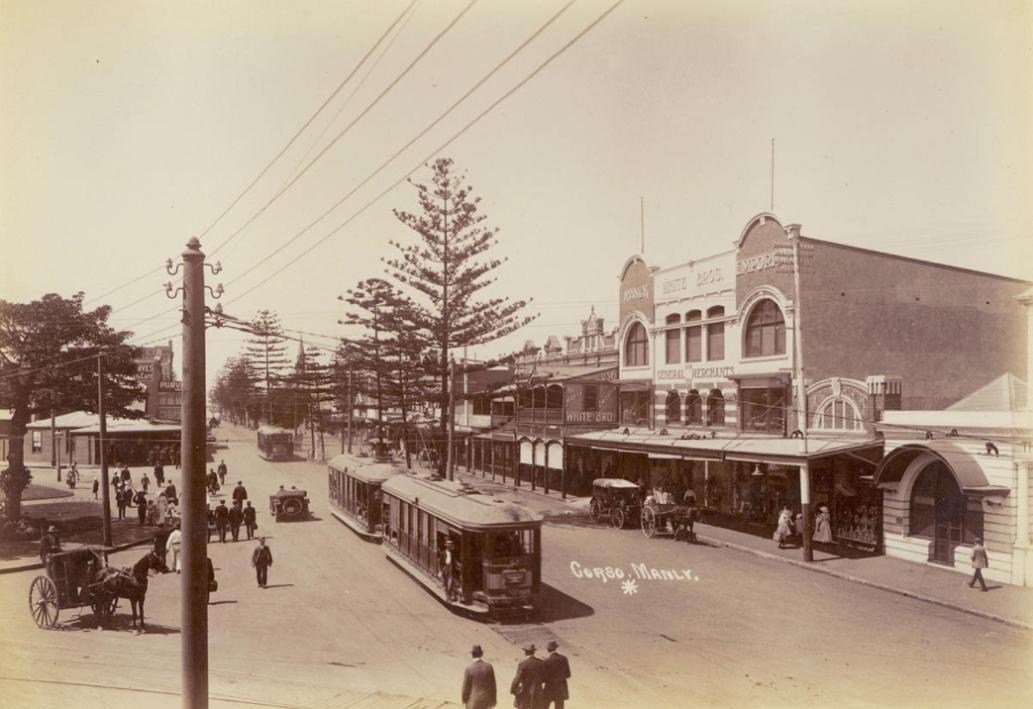
Also in 1908:
BROOKVALE TRAM EXTENSION.
Owing to considerable delay on the part of the department in connection with the proposed Brookvale tram extension, the hon. secretary of the local Tramey League communicated with the Minister upon the matter. It is some time since Mr. Lee gave his assurance that the work would be proceeded with, but there has been some difficulty over the supply of metal that appears to have caused the delay. Mr. Hanna, Under-Secretary for Public Works, states that a number of residents have, in connection with the work, signed a bond for the supply of the necessary metal- As the sureties have .found difficulty in obtaining, access to a quarry site fixed upon, the president of the. shire, requested the Minister to resume the land required for such access. The Minister agreed to resume the land, subject to the provisions of Sec. 130" of the Local Government Act, by which' the council guarantee to repay the cost df resumption. Following on the receipt of the council's guarantee the Minister will at once authorise the resumption of the necessary land. The quarrying and delivery of the metal in adequate quantity along the proposed route will bring about the commencement of the work. The local guarantee of the metal , was necessary to keep the cost of the line under £1000, "in which event any consideration of the extension by the Public Works Committee was dispensed with. BROOKVALE TRAM EXTENSION. (1908, April 13). The Daily Telegraph (Sydney, NSW : 1883 - 1930), p. 4. Retrieved from http://nla.gov.au/nla.news-article238134972
Gravel supply solved!:
BROOKVALE TRAM.
Last week Mr. Conyers, of the Public Works Department, measured up the second lot of stone from French's Forest now lying on the Pittwater-road, between North Manly and Brooklyn. The quantity was 500 cubic yards, for which Mr. Carew, the shire clerk, received a cheque for £150 this week from the department. This cheque (the second) he has passed on to the contractors, Messrs. G. Riddle and H. Thew, whose first cheque, for 585 cubic yards, amounted to £174.
Nearly 1100 yds from French's Forest, out of 4000 required for the tramway, have now been got out and paid for. The 1200 yds got out of the quarry at Brookvale by the first contractor, for which the department paid about £250, will make up the full total of 5000 yds required for the tramway. The approved stone, under the new contract, is now coming out of French's Forest very fast. BROOKVALE TRAM. (1909, April 22). The Sydney Morning Herald (NSW : 1842 - 1954), p. 4. Retrieved from http://nla.gov.au/nla.news-article15052498
On Saturday April 16th, 1910 the Manly to Brookvale section finally opened:
MANLY-BROOKVALE TRAM. ,
Official Opening.
The official opening of the Manly to Brook-vale section of what will ultimately be the Manly to Pittwater tramline took place yesterday afternoon. In a tram gaily decorated with flowers, greenery, and plumes of' pampas grass, the Minister for Works (Mr. Lee), Dr. Arthur, M:L. A., the president of the Warringah Shire, Council (Councillor Quirk), the Mayor of Manly (Alderman. Donner), and aldermen of Manly and-councillors of Warringah, with a number of visitors, journeyed to Brookvale. On the run between Manly and Warringah the Minister performed the usual ceremony of cutting the ribbon held across the front of the tram, by Messrs. P. Carew and B. M'Lean. In doing so Mr. Lee said that it was to be understood distinctly that it was never intended that the line should end at Brookvale, but should go right on to Pittwater. Therefore this was only the first step towards the "furthest North."
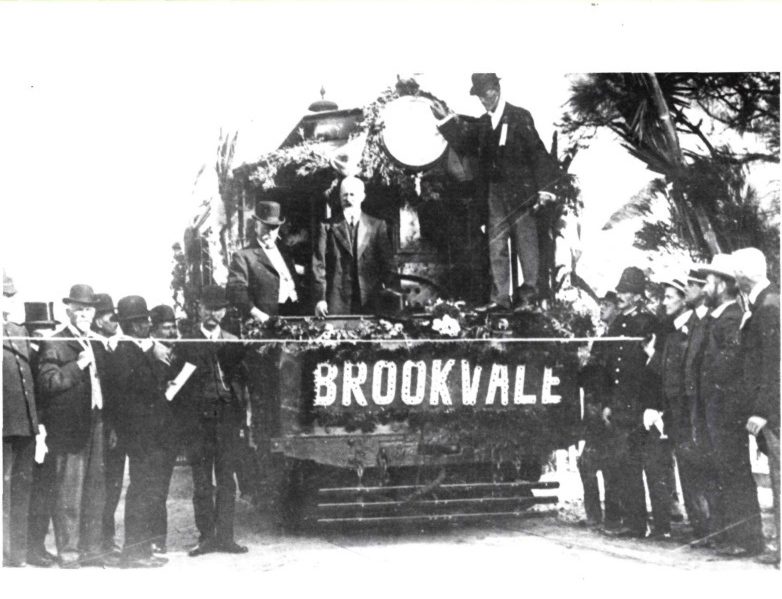
Cover of Trolley Wire December 1980: The Minister for Works, Mr. Charles Lee, is seen standing on the platform of steam motor 41A just prior to cutting the ribbon for the ceremonial opening of the North Manly to Brookvale tramway extension on Saturday 16 April 1910. This function was performed at the Manly end of the new bridge across the Curl Curl (Manly) Lagoon. Image from V.Solomon's Collection
At Brookvale the ribbon-cutting ceremony was repeated, and a number of the 'local school-children greeted the party by singing; "Advance Australia''
An adjournment was then made to a reserve for the occasion, and a toast- programme was submitted. Proposing 'Mr. Lee's health, Councillor Quirk, who presided, gave some interesting figures showing the progress made by the Manly tram -its' Indicating the prospects of the new extension. He presented the Minister for Works with the scissors with which the ceremony had been, performed.
Mr. Lee, In replying, said that he was aware that there had been some little "rift in the lute" regarding that particular line, but he had had his own ideas as to how the work should be carried out. Some estimable gentlemen had thought that it should have run night through to Pittwater at once, but they had forgotten that the run from the Spit to Manly had a still stronger claim. What, he, asked, had brought 26,000,000 persons to Manly every year? They did not all come to town to swim or to drink, a large number came simply for a day's outing. And, if the tram was extended to Pittwater It was only reasonable to suppose that hundreds of thousands of passengers would use it. The line had cost £10,321 and great credit was duo to the local council for promoting its construction.
The toast of "Parliament" was proposed by Councillor, Rawson and replied to by Dr. Arthur, who was presented by the chairman with, an album containing photographs of beauty spots in the district.
Mr. S. L. Ridge, secretary of the Manly to Brookvale Tramway League was presented with a gold curb chain and medal In recognition of the services be had rendered. MANLY-BROOKVALE TRAM. (1910, April 17). The Sunday Sun (Sydney, NSW : 1903 - 1910), p. 7. Retrieved from http://nla.gov.au/nla.news-article226877833
The following year:
Opening Up the Beaches— The Brookvale-Narrabeen Tramway Extension.

Narrabeen Beach, which will be opened up by the new tramway.
.jpg?timestamp=1648941110342)
The President of Warringah Shire (Mr. Ralston) Presenting Mr. Arthur. Griffith, M.L.A., with a Gold Spade as a memento of the ceremony of turning the first sod of the tramway.
.jpg?timestamp=1648941033110)
Master Sturt Griffith Turning the First Sod.
Opening Up the Beaches -- The Brookvale-Narrabeen Tramway Extension. (1911, August 2). Australian Town and Country Journal (Sydney, NSW : 1870 - 1919), p. 33. Retrieved from http://nla.gov.au/nla.news-article263721495
The construction:
TRAM WAY CONNECTION WITH NARRABEEN.
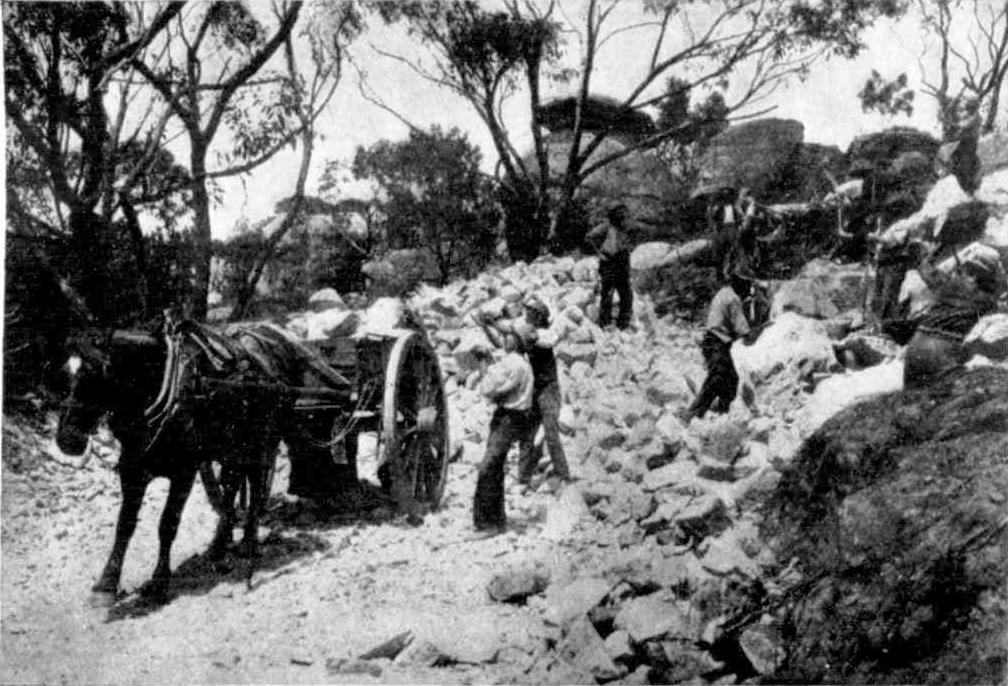
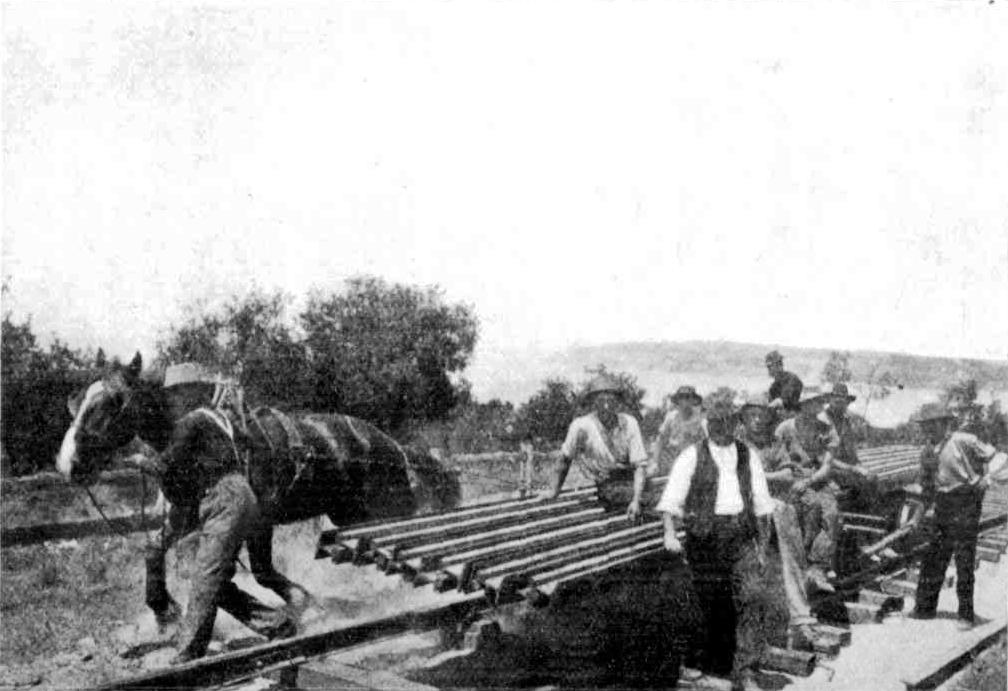
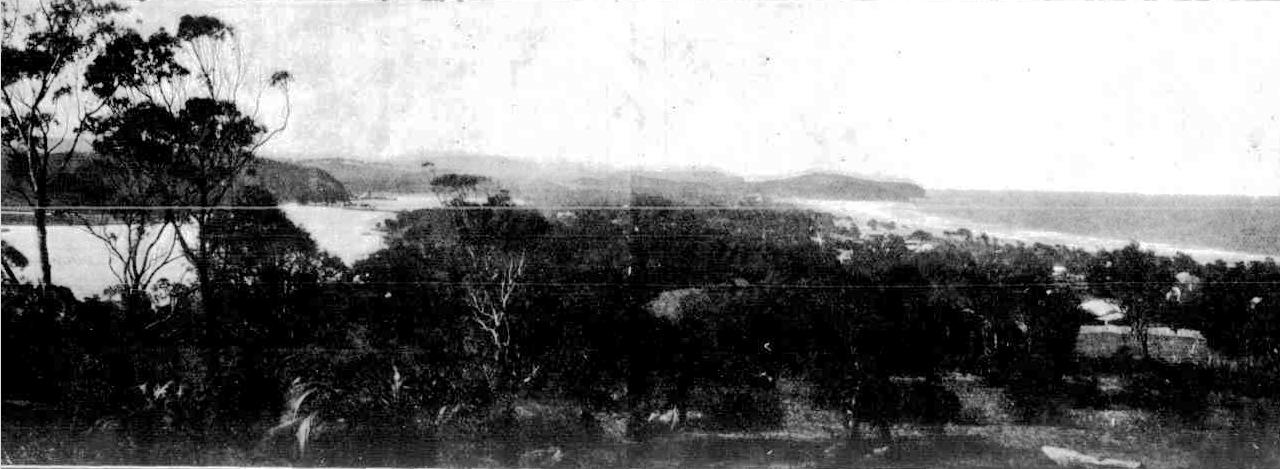
The extension to Collaroy opened and the work to extend it right to the lagoon commenced the same month:
There is also a distinct advance movement in real estate in the direction of Narrabeen. To-day the tramway is to be officially opened, and from this morning the public will have an hourly tram service between Manly and Narrabeen for 5d each way, and as the last tram from Manly for Narrabeen is somewhere about 10 p.m. the service will be a great improvement upon the present one of coaches and 'buses, running from Manly at the rate of only three or four trips a day, and at a cost to the traveller of at least 1s each way. The sales pf land at Narrabeen this season promise to be greater than last year. In fact, right along the Ocean beach, as far as Pittwater, estates will be opened up, and people will have an opportunity of securing a week-end allotment in a picturesque spot on that magnificent stretch of coast line from Manly to Pittwater. REAL ESTATE. (1912, August 3). The Sydney Morning Herald (NSW : 1842 - 1954), p. 18. Retrieved from http://nla.gov.au/nla.news-article15326801
CONNECTING CITY AND SUBURBS.
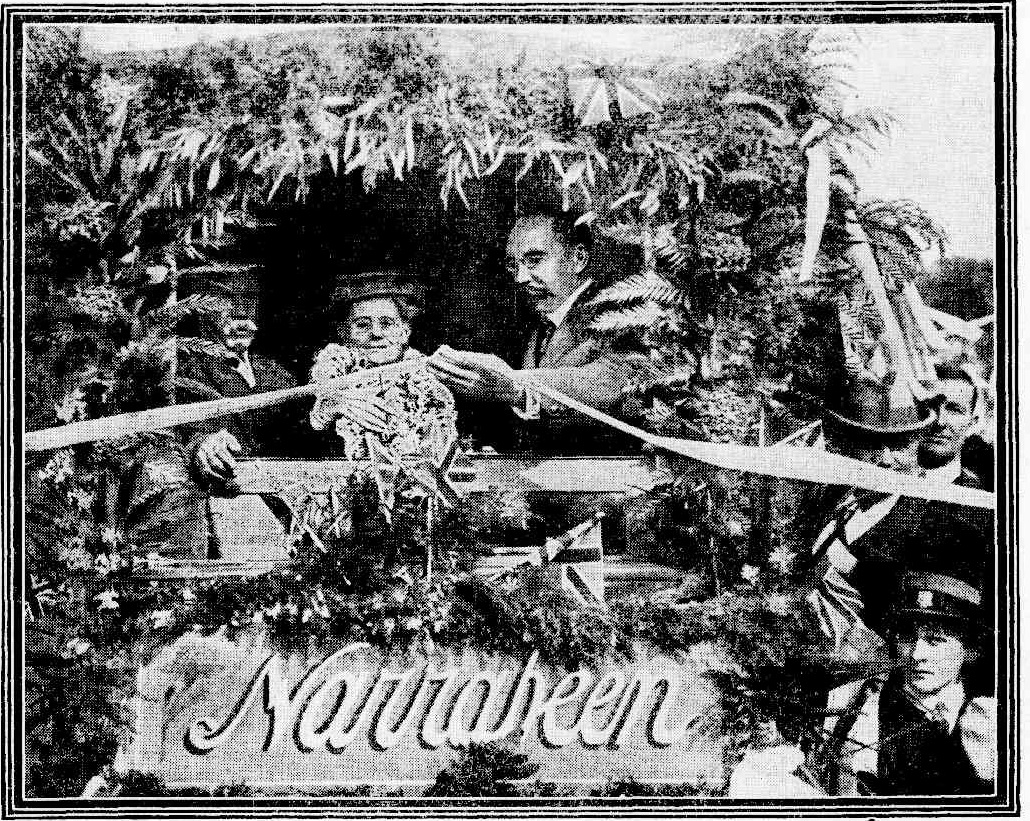
Mrs M’GOWEN (WIFE OF the PREMIER) cutting the ribbon, and declaring the new tramway extension from Manly to Narrabeen open for traffic. Mr. Arthur Griffith, minister for works, is holding the ribbon. CONNECTING CITY AND SUBURBS. (1912, August 5). The Daily Telegraph (Sydney, NSW : 1883 - 1930), p. 11. Retrieved from http://nla.gov.au/nla.news-article238632940
A Banquet was held at the Narrabeen Hotel afterwards - and this is one of the few images found that shows the interior of that place as it was then:
OPENING THE TRAMWAY.
A special tram nicely bedecked with ferns, flowers and ribbons conveyed a number of invited guests from the wharf at Manly to Collaroy, where the opening ceremonies — starting of the tram and turning on of the water — took place. Mrs. M'Gowen, wife of the Premier, with a pair of golden scissors cut the ribbon stretched across the end of the line at Collaroy Beach, and Mr. Griffith, Minister for Works, turned on the water in the presence of a large gathering of interested spectators. Among those present were: — Mr. J. H. Cann (State Treasurer), the Lord Mayor (Alderman G. T. Clarke), Dr. Arthur, Messrs. Black, Keegan, Levy, Nobbs, Ms.L.A., and Colonel Ryrie, M.P.; also representatives of the Water and Sewerage Board, Mr. W. J. Milner (president),
Alderman T. H. Barlow (vice-president), Mr. T. Henley, M.B.A., and Mr. J. Leitch. Mrs. M'Gowen, to mark the occasion, was presented with a, diamond brooch shaped like a tram.
THE WATER SUPPLY.
The water supply at Narrabeen consists of four miles of 6in wood pipe for 250ft head pressure. In testing this pipe line it gave excellent results — a great testimony to the pipes manufactured by the Australian Wood Pipe Company. Limited — as in some places the pipe was standing an over-burden of nearly 33 1-3 per cent, more than it was specified to stand. The estimated cost of iron pipes was £3100, the wood pipes costing £2400, showing a saving of £700, or equal to 30 per cent.
At a banquet given by the Australian Wood Pipe Company, Limited, to celebrate the opening of the water supply, held at Bacon's Narrabeen Hotel in the evening, there was a large and representative gathering. Mr. C. E. Ludowici presided. Among those present were Mr. Griffith (Minister for Works), the Lord Mayor (Alderman G. T. Clarke), Dr. Arthur and Mr. T. Henley, (Ms.L.A.), Mr. H. E. Pratten (president of the Chamber of Manufactures), Alderman Middleton (Mayor of Mosman), the aldermen of the Manly Council, and councillors of the Warringah Shire. . Mr. Griffith, in replying to the toast of 'The Ministry" said that those people who stated that they were heavily taxed in Australia did not know what they were talking about. The revenue derived from the railways and tramways was not necessarily the taxation of the country; it was direct payment for services rendered. Those who would lead them to believe otherwise were making misstatements to the people. The Minister added that no article that could be produced in this country ought to be imported. ‘’The system of wooden pipes for water supply was economical, and the Australian Wood Pipe Company had carried out the work" in a most satisfactory manner. Dr. Arthur thanked the Australian Wood Pipe Company for the activity with which they had brought the water to Narrabeen, and Mr. T. Henley also thanked the company for coming to the rescue of the Government at the time when pipes were scarce. Mr. A. G. M'Donald proposed "The Visitors," which was responded to. by Alderman G. T. Clarke (Lord Mayor), and Messrs. W. G. Milner, A. G. Pratten, J. Leitch, G. H. Barlow, and W. Hews (president of- the Warringah Shire Council). Other presentations made during the afternoon were a diamond bracelet to Mrs. Arthur (wife of Dr. Arthur, member for the district), and Mr. Griffith was handed a cable bracelet for Mrs. Griffith from the Australian Wood Fine Company, Limited, which laid the pipes for the water supply.
BACON'S HOTEL NARRABEEN.
This establishment is well and favorably known to visitors to Narrabeen, and the owner (Mr. Charles Bacon) is determined to keep ahead of the times. Mr. Bacon has been at Narrabeen for IS months, and prior to that was caterer at the Manly Golf Club for two years. Recognising that the opening of the tramway would result in a great influx of visitors, Mr. Bacon has lately completed extensive and substantial alterations to the hotel, and part of the general scheme of improvement will be the addition of another storey to the premises. Plans of this work are now being prepared by Mr. Trenchard Smith, and already a new and handsomely-fitted saloon bar has been added, while the dining-room has been renovated and re-decorated, the table appointments being by Walker and Hall. The new roof will be a flat one, from which splendid views of ocean and lake may be obtained.
The capabilities of the Hotel Narrabeen may be judged by the fact that the banquet given by the Australian Wood Pipe Company, to celebrate the turning on of the water supply, on August 3, was held in the main dining-room, nearly 100 guests being present. Mr. Bacon makes a special feature of the midday meal on Sundays, and has a tea garden for afternoon tea. Mr. Bacon is a prominent resident of the district, and is the president of the Narrabeen Progress Association, and also one of the bondsmen for the water supply. The Hotel Narrabeen is up-to-date in every respect; it is connected with the city water supply, and has extensive stabling and garage accommodation. The floors of the garage and stable are concreted, and vehicles ' and cars may be washed down. A septic tank is also in course of construction.
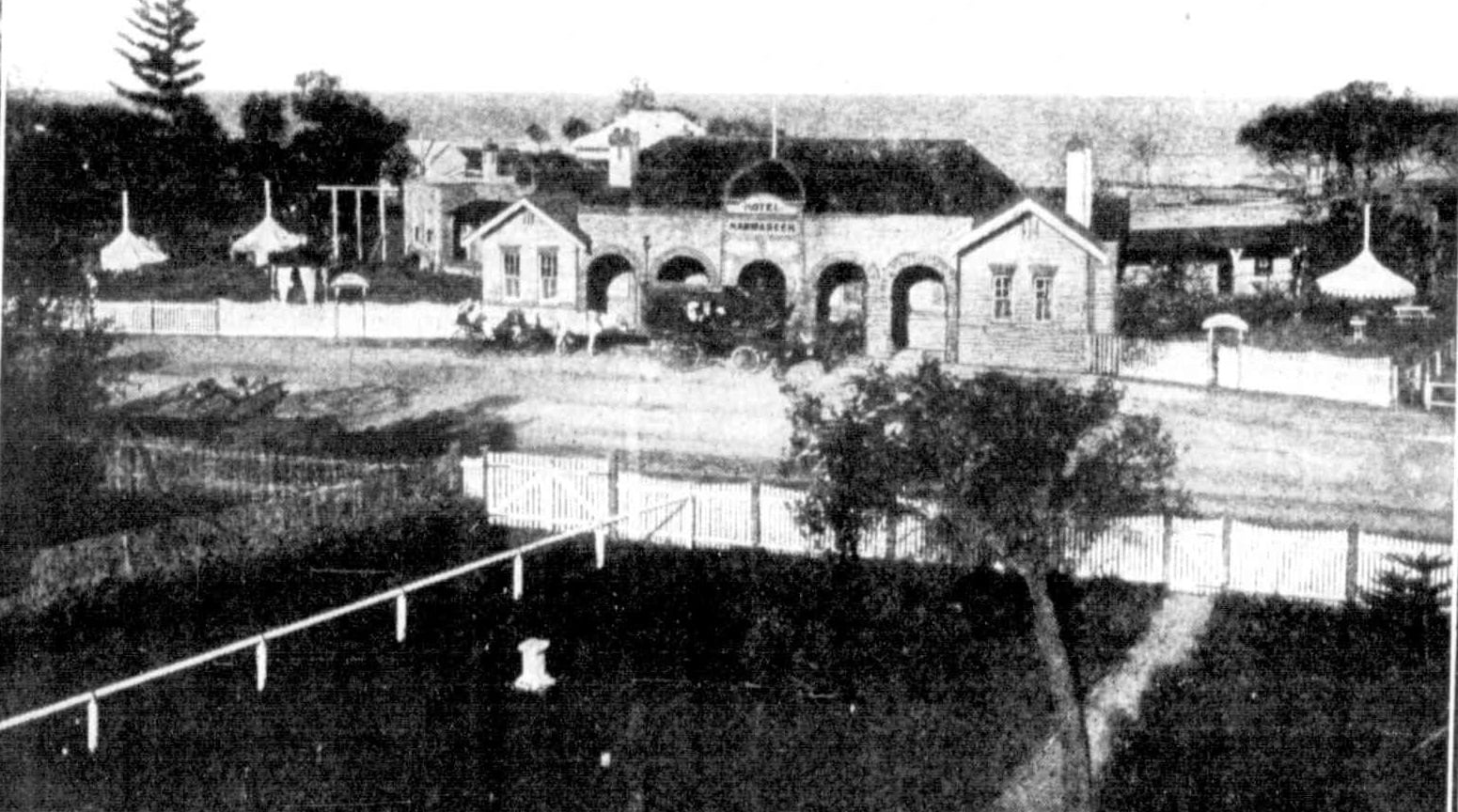
Photo: Mr. Charles Bacon's Hotel Narrabeen.
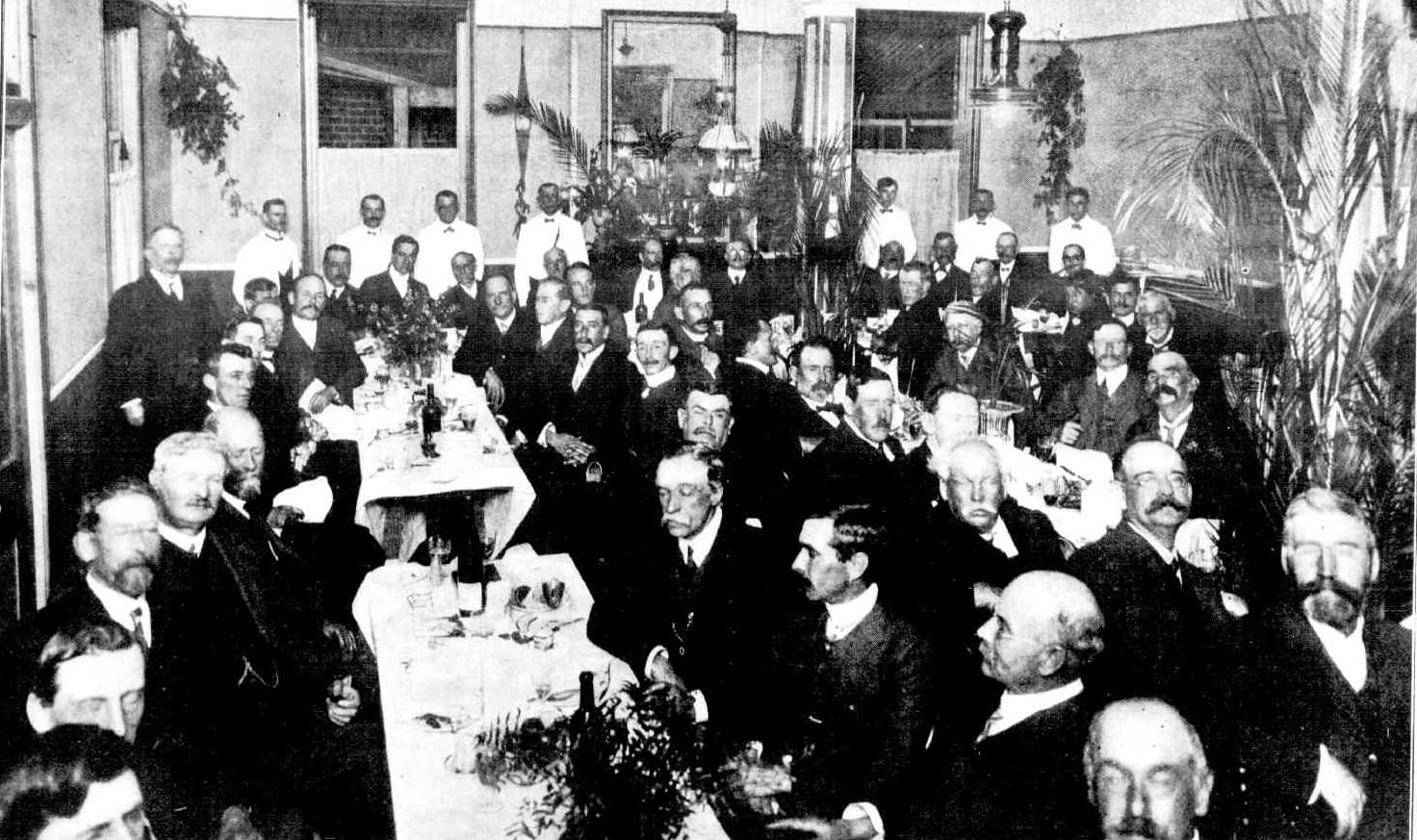
Photo: Banquet given by the Australian Wood Pipe Company, Limited, at Bacon's Hotel Narrabeen, on August 3, to celebrate the turning on of the water supply.
The water mains— wood pipes— were supplied by the company, and the advantages of the pipes were praised by the Minister for Works (Mr. Griffith) and others at the banquet.
Opening Up a Beautiful District -- Tramway and Water Supply for Narrabeen. (1912, August 7). Australian Town and Country Journal (Sydney, NSW : 1870 - 1919), p. 32. Retrieved from http://nla.gov.au/nla.news-article263890494
Although some reports state it was Mrs. Griffith who cut the ribbon, a comparison of the lady above and an article run the same (below) with Mrs. Emily McGowen (nee Towner) will show the same face.
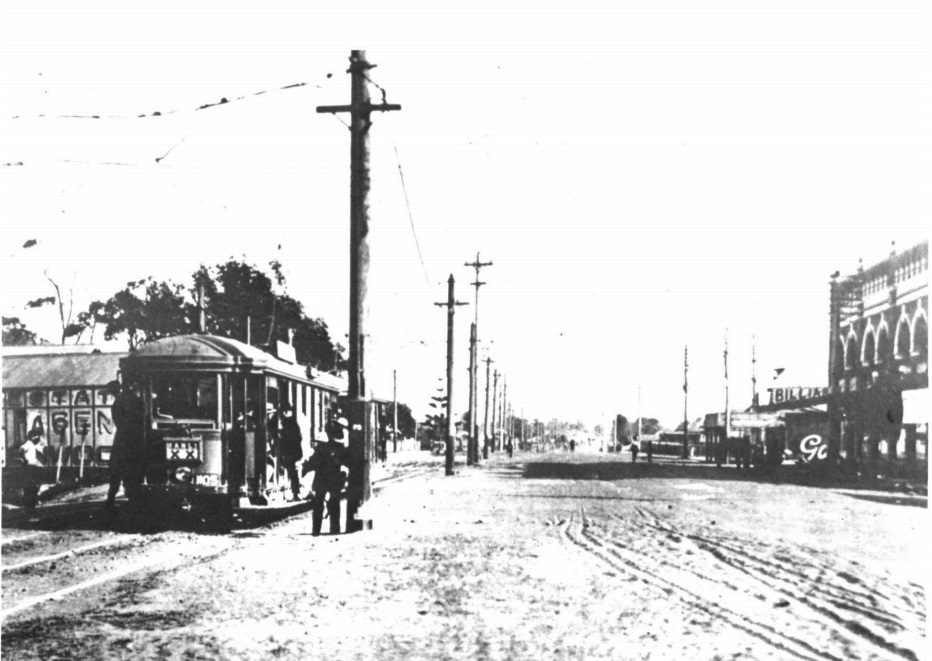
An O class tram headed by car 1105 at Collaroy bound for Manly, Circa 1920. from D O'BRIEN COLLECTION - appears Trolley Wire December 1984 as part of k. McCarthy series on Manly to Narrabeen Trams Historic articles
The mile and a half extension right to Narrabeen bridge took over a year. The first Tram rides commenced on Monday December 8th, 1913 and this time Mrs. Griffiths did indeed do the ribbon cutting:
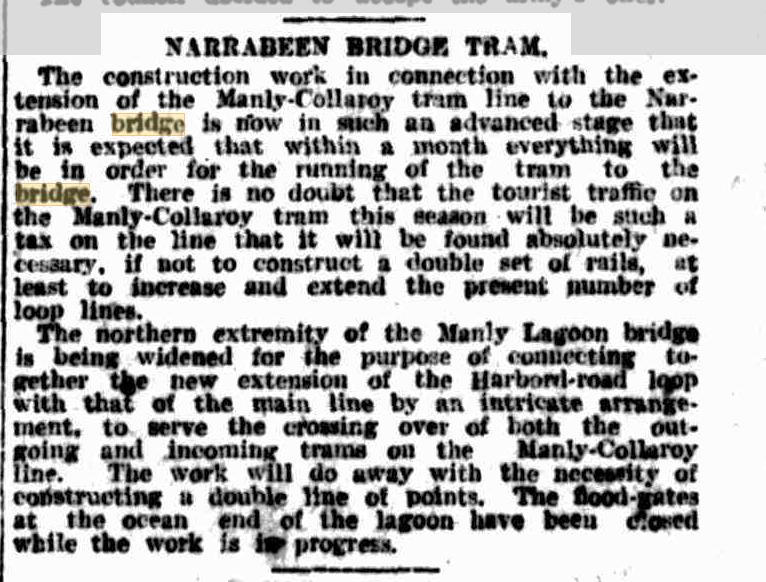
NARRABEEN TRAM.
Commencing Monday next, the extension of tram line from Collaroy Beach to Narrabeen will be opened for traffic, and a regular service of trams will be run daily between Manly Pier and Narrabeen, connecting with steamers to and from Circular Quay. NARRABEEN TRAM. (1913, December 6 - Saturday). The Sydney Morning Herald (NSW : 1842 - 1954), p. 22. Retrieved from http://nla.gov.au/nla.news-article28121325
NARRABEEN TRAM.
A trial trip was made on the tramway extension from Collaroy Beach to Narrabeen Lakes on Thursday. The new line is about a mile and a quarter in length, and the trams will be running on it about the middle of next week. Arrangements are being made by the residents to celebrate the opening. NARRABEEN TRAM. (1913, December 6). The Daily Telegraph (Sydney, NSW : 1883 - 1930), p. 9. Retrieved from http://nla.gov.au/nla.news-article238971336
The official opening took place on Saturday December 20th, 1913, and included a carnival:
NARRABEEN TRAM OPENING.
The official opening of the Narrabeen tram extension will be performed on Saturday next, at 3.30, by Mrs. Arthur Griffith, wife of the Minister for Works. The Warringah Shire Council and a committee are making arrangements to suitably celebrate the occasion.
A Venetian carnival on the lakes will be held at night, and there will also be a display of fireworks. The Pittwater tramway and transit committee has arranged to take the official party for a trip through the Pittwater district, including Newport, Bay View, and Church Point. Refreshments will be partaken of at the latter place, after which the party will journey back through Narrabeen for the purpose of witnessing the evening carnival.
The tram has been running since Monday last on the route, and the traffic on the line is regarded as satisfactory. Passengers are now landed right at the Narrabeen Lakes, and within easy distance of the beach and other adjoining tourist resorts. NARRABEEN TRAM OPENING. (1913, December 12). The Daily Telegraph (Sydney, NSW : 1883 - 1930), p. 7. Retrieved from http://nla.gov.au/nla.news-article238960637
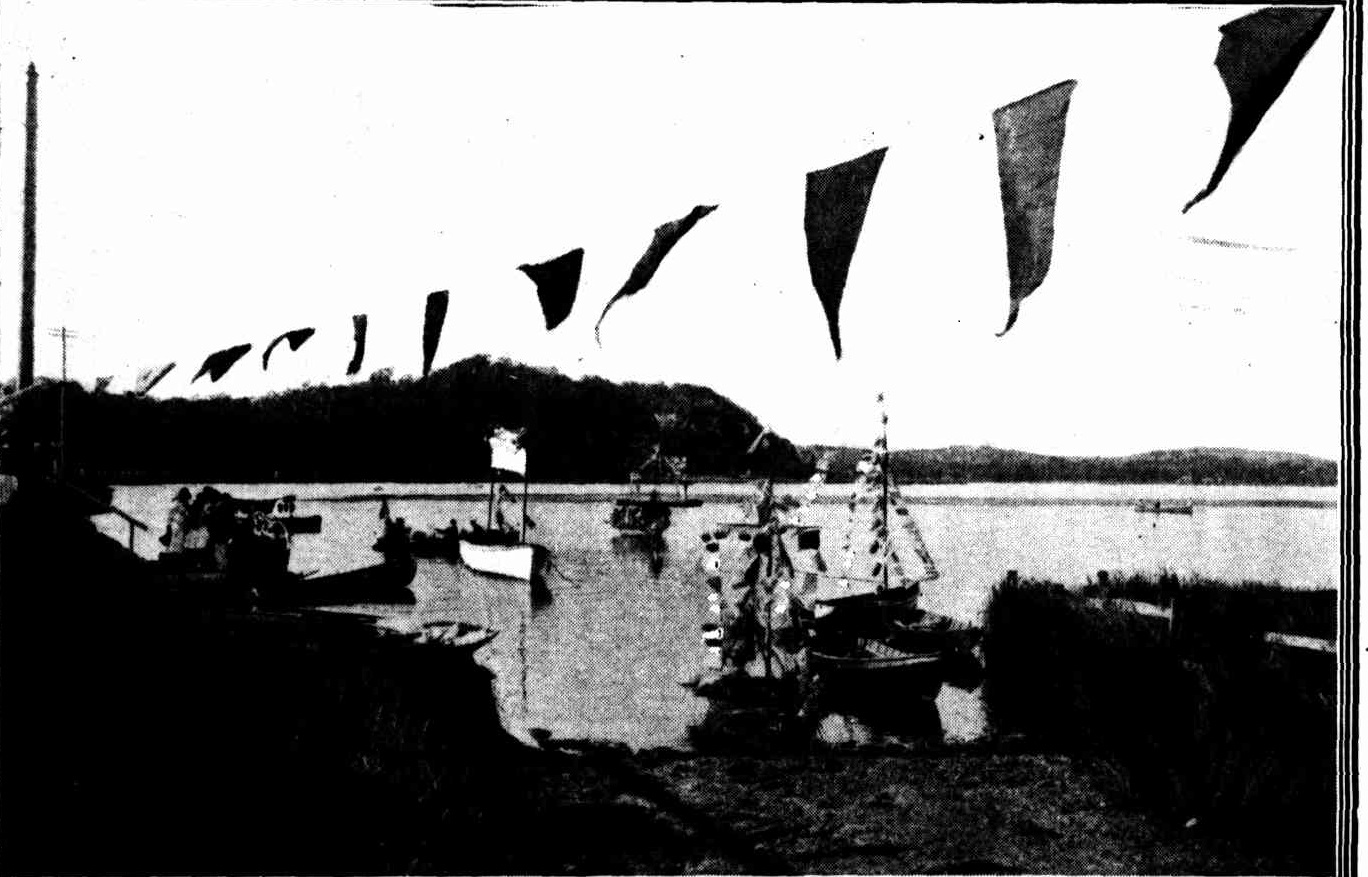
A Holiday at Narrabeen, between Manly and Newport. This view was taken on the occasion of the recent carnival at Narrabeen Lake in honour of the extension of the tramline to the bridge. OUTDOOR AUSTRALIA. (1914, January 7). Sydney Mail (NSW : 1912 - 1938), p. 10. Retrieved from http://nla.gov.au/nla.news-article158397083
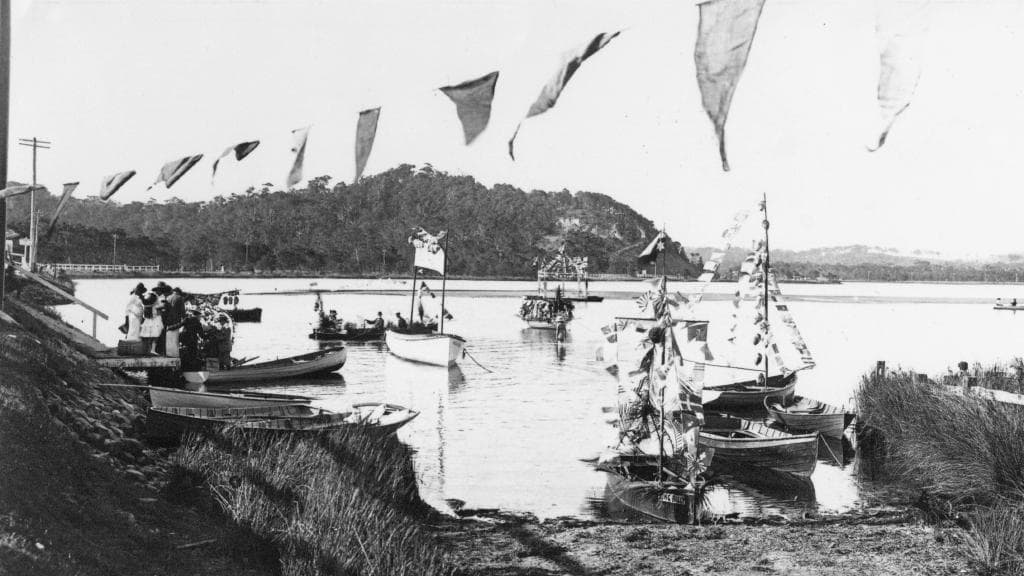
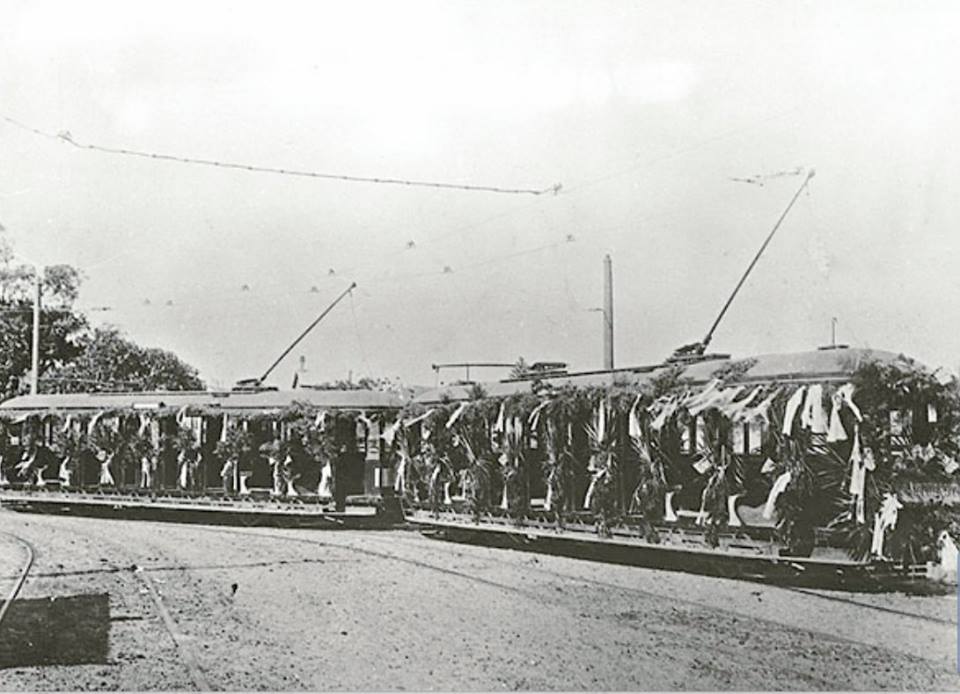
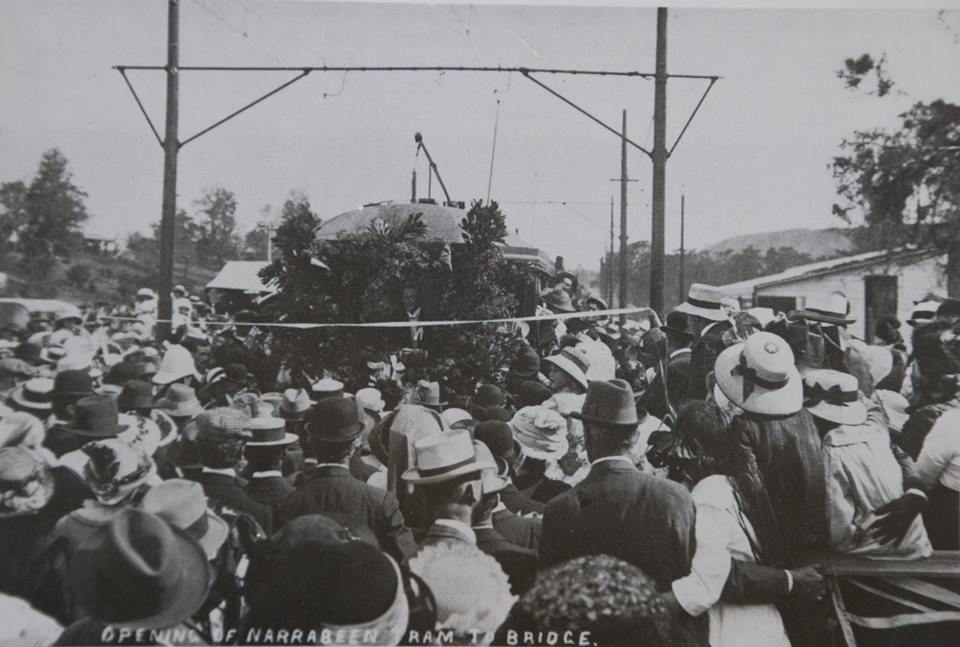
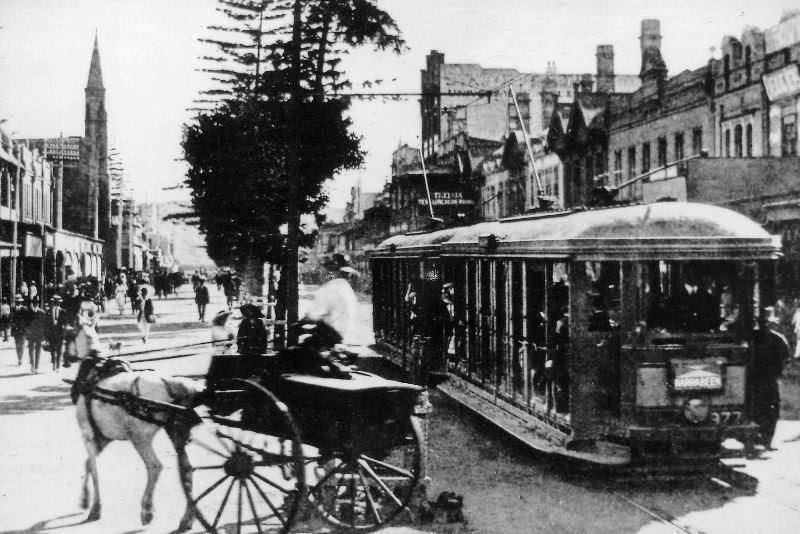
The first fatality of the new tram can be ascribed to a Sydney resident seeking a place for a future holiday:
NARRABEEN TRAM FATALITY.
Concerning the death of John Nibblett Overall, 41, of Summer Hill, the City Coroner yesterday recorded an open verdict of death through his being run over by a tram at Narrabeen on December 16.
In evidence, Septimus Davis, an engine-driver, of Brookvale, said that at 7.25 p.m. on December 16 he was in front of a Manly-Narrabeen tram. When between Clarke and Devitt streets he noticed deceased, who carried a kit-bag, coming from behind a tin shed. Deceased rushed towards the tram at right angles. When four or five feet away he dropped his bag, and took a leap, as though to cross the line. Deceased was run over.
Mrs. Edith L. Overall said that for 25 years her husband had been employed in the Sydney Mint as an artificer. He went to Narrabeen to arrange about a cottage for the holidays. He was very short-sighted, and could hardly see without glasses. NARRABEEN TRAM FATALITY. (1913, December 24). The Sydney Morning Herald (NSW : 1842 - 1954), p. 17. Retrieved from http://nla.gov.au/nla.news-article15482882
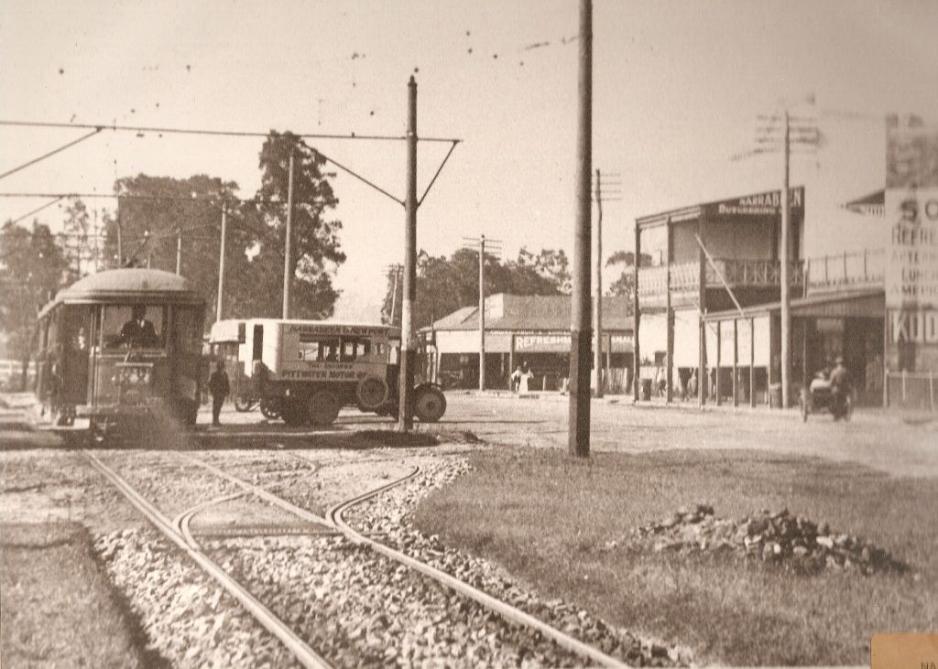
Narrabeen Terminus c1925: From and courtesy of Trams DownUnder Archives at http://tdu.to/30543.att
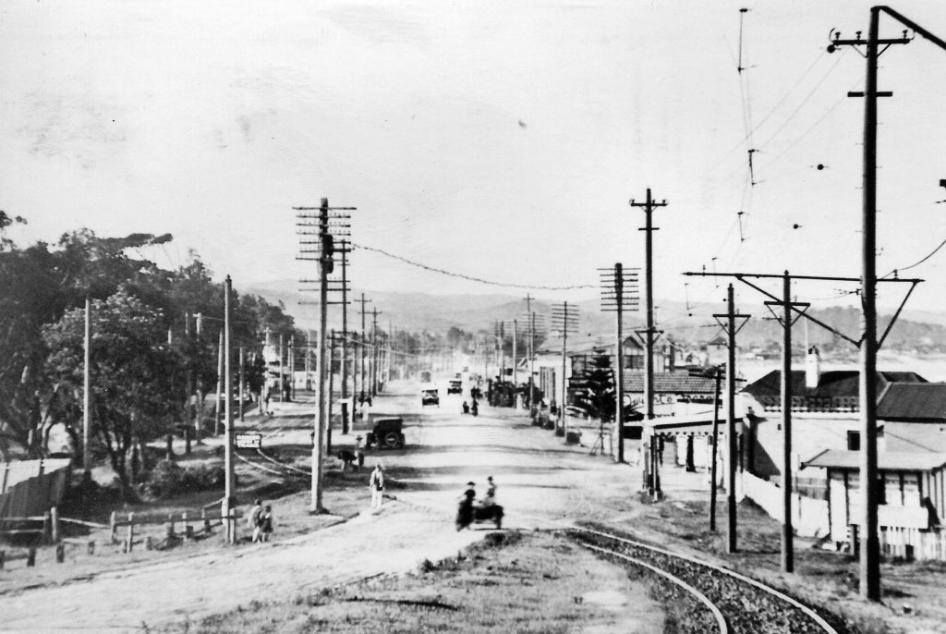
A mile south of Narrabeen Tram Terminus, circa 1925. Visit; The House at the end of the Road, Narrabeen
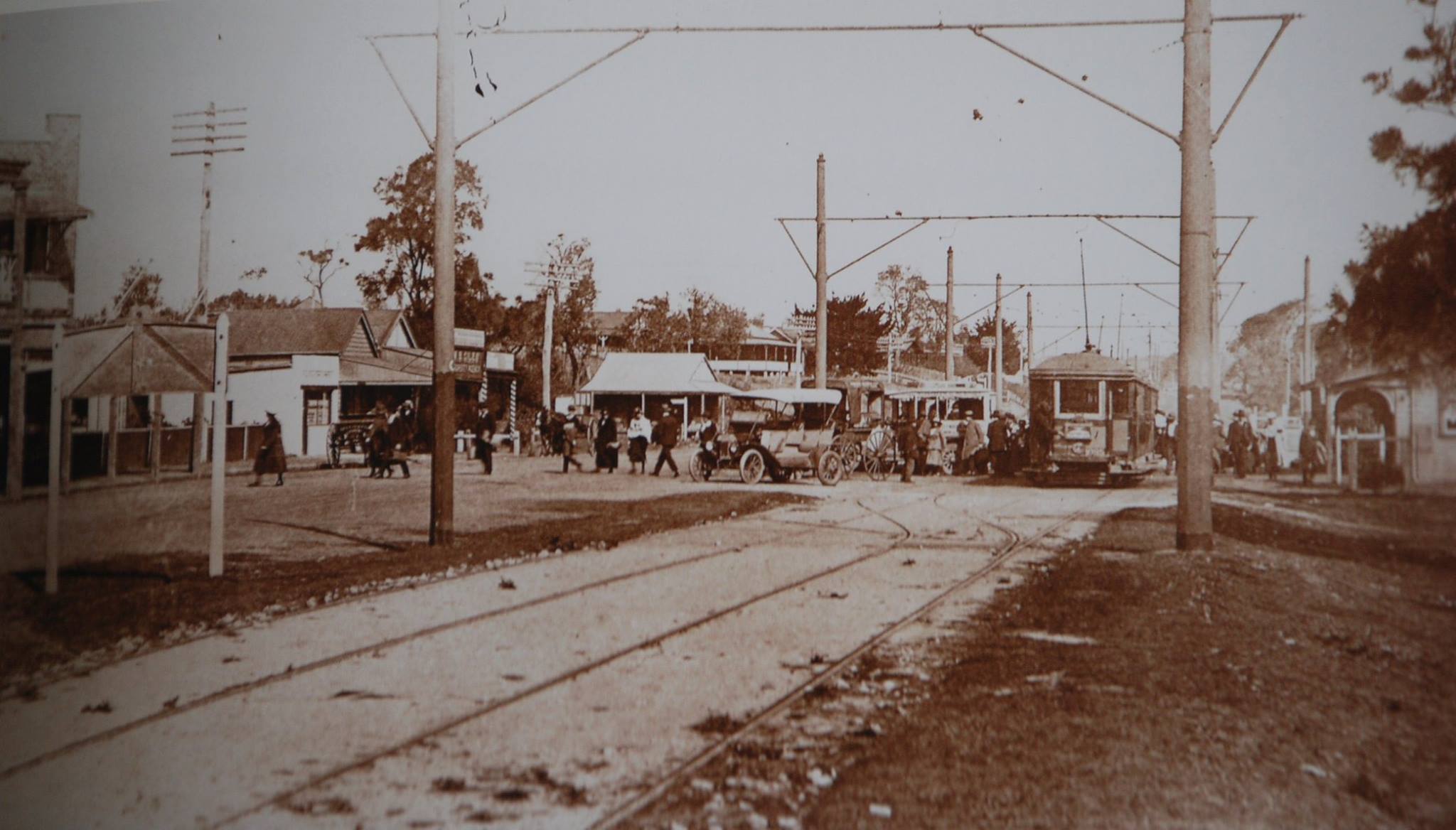
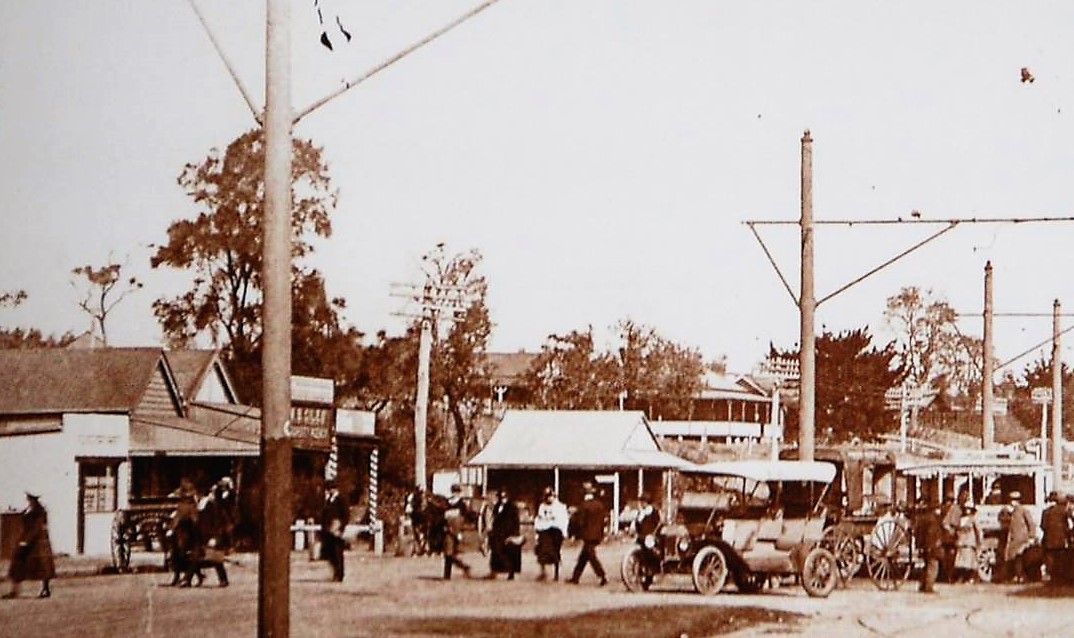
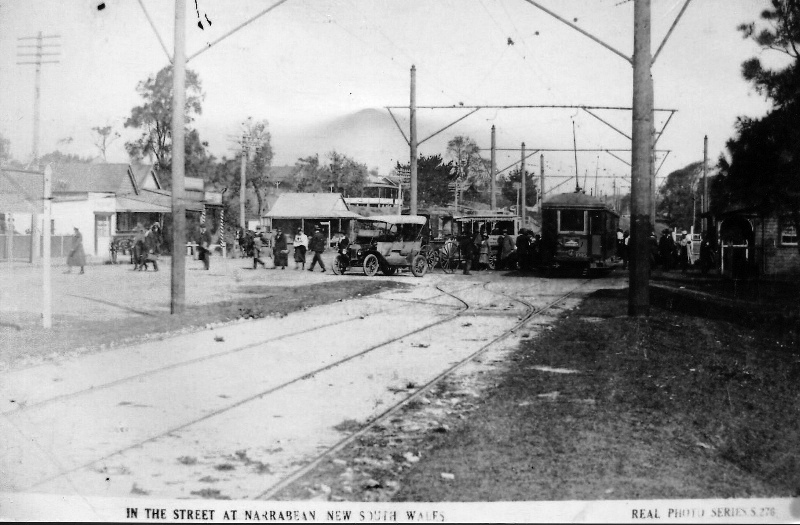
Narrabeen Tram Terminus - the Liberty Hall can be seen as the structure on the rise with brick piles still in place just above vehicle roof. from and courtesy D O'BRIEN COLLECTION
By the 1920s, the Sydney Trams system had reached its maximum extent and became, in many ways, a victim of its own success. The overcrowded and heaving trams running at a high frequency, in competition with growing private motor car and bus use, ended up being blamed for the congestion caused by the latter. Competition from the private car and unregulated private bus operators created the perception of traffic congestion which begun the gradual closure of lines from the late 1930s, including the run to Narrabeen:
STATE 'BUSES FROM MANLY TO NARRABEEN
MORE COMPETITION FOR OUR TRAMWAY SYSTEM
START TO-DAY
TIME-TABLES, SECTIONS AND FARES ARE LAID DOWN
THE Commissioner for Road Transport, Mr. Maddocks, announced yesterday, that a further Government-controlled omnibus service would be commenced today between Manly wharf and Narrabeen Peninsula. A 25 minutes service will be maintained, commencing at 7.61 a.m. from Manly Wharf, and 8.23 a.m. from Narrabeen Peninsula. On Saturdays, an additional trip will be run from Manly ; At 10.26 p.m. and from Narrabeen at 11.2 pm.
On Sundays and holidays the first trip from Manly will be 8.41 a.m., and from Narrabeen 9.13 a.m.. and the last trip 9.36 p.m. and 10,13 p.m. rcspbctively on Sundays, and 10.26 . and 11.3 p.m. on holidays.
As from next Tuesday, January 3, a regular 30 minutes' service will be in operation on weekdays, commenclng at 7.18 a.m.- from Narrabeen and 7,51 a.m. from Manly rWharf, connecting with the ferries. The last trip will be at 10,19 p.m from Manly and 10.41 p.m. from Narrabeen.
Four Sections
There will be four sections, and fares will be; From Manly wharf to Brookvale 6d, to Dee Why 8d., to ColIaroy 10d., and to Narrabeen tram terminus and Narrabeen Peninsula 1/-. Sectional fares are 6d. for one section, 8d. for two sections, and 10d. for three sections. The fare between Narrabeen tram terminus and Narrabeen Peninsula will be 3d. Additional trips will be run on the Manly wharf-Cremorne service on New Year's Eve at 11.52 p.m. and 12.7- a.m. from Cremorne, and 12.22 a.m. and 12.37 a.m. from Manly wharf. STATE 'BUSES FROM MANLY TO NARRABEEN (1932, December 31). The Labor Daily (Sydney, NSW : 1924 - 1938), p. 5. Retrieved from http://nla.gov.au/nla.news-article237064164
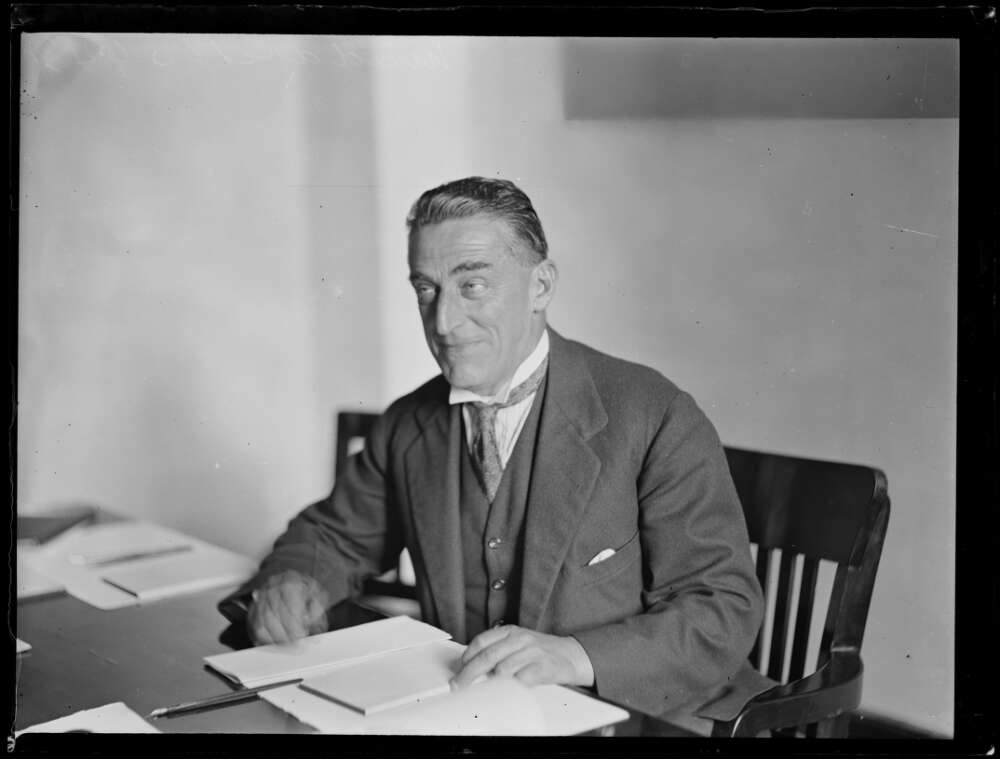
Fairfax Corporation. (1930). Commissioner of Road Transport and Tramways Mr Maddocks sitting at a desk, New South Wales, 8 August 1930 Retrieved from http://nla.gov.au/nla.obj-160703399
HE'LL BE DRIVING ONE SOON
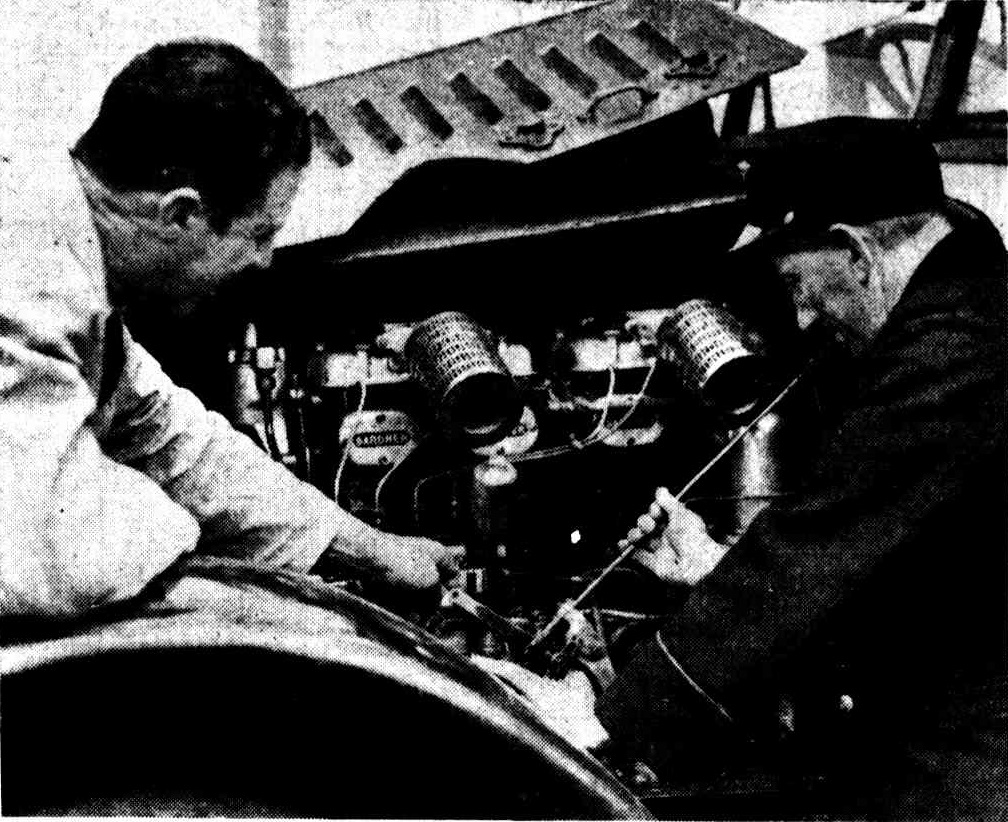
A tram-driver being instructed in the intricacies of a motor bus engine today at the Manly bus depot, when tram drivers and conductors were taught how to Handle buses. The classes are preparatory to the abandonment of trams on the Manly-Narrabeen, Manly-Spit, and Wynyard-Northbridge lines. HE'LL BE DRIVING ONE SOON (1939, May 1). The Sun (Sydney, NSW : 1910 - 1954), p. 3 (LATE FINAL EXTRA). Retrieved from http://nla.gov.au/nla.news-article230883218
With the opening of the Sydney Light Rail runs towards the end of this year another era of Sydney Trams will open. If you can it will be well worth collecting any tickets, programmes, photographs and associated materials - perhaps even try and be among the first to use these new-old modes of transport as, at some time in the future beyond that - these will be collectors items that will be well worth having for posterity.
In the meantime, if you'd like to visit these great old relics of the past, the Sydney Tram Museum must be your destination!:
Sydney Tram Museum
Cnr Rawson Avenue (Old Princes Highway) & Pitt Street, Loftus
Open Sunday and Wednesday from 10am
Last tram to Royal National Park departs Sunday & public holidays: 4.15pm
Wednesday: 2.15pm
Adults: $18
Concession: $12
School children: $10
Pre-school children: Free
Special event days excepted. Events MAY have different prices.
Entry tickets allow you: Unlimited tram rides and Museum entry
Visit: https://www.sydneytramwaymuseum.com.au/
References and Extras
- TROVE - National Library of Australia
- Trolley Wire - Australia's Tramway Museum Magazine -
- The Manly Tramways - N.S.W. 1903-1939. A. 1903-1907 The Steam and Horse Tramway Era. By K. McCarthy. TROLLEY WIRE, OCTOBER,1979. Retrieved from https://www.sydneytramwaymuseum.com.au/members.old/Trolley_Wire/184%20-%20Trolley%20Wire%20-%20Oct%201979.pdf
- THE MANLY TRAMWAYS - NSW 1903-1939, D. 1911-1912 THE END OF STEAM OPERATION By K. McCarthy . TROLLEY WIRE JUNE 1983. retrieved from https://www.sydneytramwaymuseum.com.au/members.old/Trolley_Wire/206%20-%20Trolley%20Wire%20-%20Jun%201983.pdf
The Sydney Tramways
Their History and Wonderful Development--Total Capital Already Expended, Over Three and a Half Millions Some Interesting Facts and Figures.
II
(FOR THE 'SUNDAY TIMES'— BY ARNOLD DENHAM.)
THE EVOLUTION OF THE CARS.
The first tram (1861), as has already been ?mentioned, was a horse-car. It 'was of twe storeys, and dra'wn by four horses. The steam cars of 1879 were also of the 'double-decker' pattern, and were worked by Baldwin motors. The roof and sides were not covered with wood, an awning and hangings taking their place. The next type could hardly be called an improvement, and the trams were not inappropriately known as 'Jumttos.' The motor .was built into the passenger car, and nervous occupants on the upper storey generally seemed to have been in doubt whether the motor would explode and blow them in the air^ or. whether the car would wobble over and crush them to earth.
Other 'double-deckers' in use in the early eighties were euphoniously known as 'The Pets.' There were four compartments on the lower deck of the first car, and six on the 'trailer,' or car following it. The cars were supported by four rigid wheels, which were afterwards replaced by eight bogie wheels.
In 1885 the double-decked cars began to disappear, and by 1889 most of them had been broken up or converted into the present 'standard' steam passenger cars, which are still running on a few of the lines and at Newcastle and Broken Hill. The recent cable cars are too* well-known to need any detailed description, except from a technical point of view, which would be out of place here.
In 1895 experiments were made in Elizabeth-street with a 'standard trailer,' then drawn by steam. The car was fitted with electric motors fixed to the axles, and the current supplied by accumulators, the batteries being fixed beneath the seats. The tram, which was one of the ordinary type then running, mystified country visitors, who gazed at it with open mouthed wonder, for it had apparently no motive power. It is even said that on its trial trip a policeman endeavored to arrest it, thinking it was a runaway. The experiments, however, with 'Lone Jimmie,' as the solitary wayfarer was nicknamed, were not successful,' and it was relegated to the limbo of forgotten lumber.
The first electric cars imported were fitted with rheostats (a contrivance for regulating the power to the motors by absorbing part of it), but the subsequent cars had improved controllers. The first motors beneath the cars were uncovered, with the result that the working parts were smothered with dust, which prevented their satisfactory working. They are now cased in, and. the whole metropolitan electric system is at present regarded as near perfection as possible.' If the casual passenger looks at the controller beside the driver (which starts, stops, and regulates the speed of the tram), he will find close on a score of patent dates embossed on it, notifying the various improvements that have taken place in the apparatus from time to time. This gives some idea of the patience and ingenuity that have been expended on one piece of mechanism alone.
The earlier electric lines were all single trades, and only one row of poles, running on one side of the line, was used to convey the overhead wire. The trolly-pole was fixed to the side, down which the current passed to the motors underneath the tram. Now, with the advent of double lines, the trolly-pole rises from the top of the car. The pattern of the electric -rolling stock has varied slightly from time to time, but the principal types now in use consist of the bogie combination car, the cross-seat bogie car, the four-wheeled cross-seat car, the four-wheeled closed car, and the 'Brill' car, the- seating capacity varying from 26 to 70 persons. The current to work these trams is supplied by the Ultimo power-hourse and six substations at Hunter-street, Randwick, Botany, Waverley, Newtown, and North Sydney. Last year the total cost for the erection and plant was £601,442, and the power-house itself is considered the largest and most complete in the Southern Hemisphere. Seven large car sheds have been built in the city and suburbs with a capacity of housing from 55 to '187 cars each.
The trams have an average speed of eight miles an hour in the city, and ten' miles an hour in the suburbs. On special occasions, such as public holidays race days, and cricket matches they. are capable (by means of trailers), of transporting 14,000 from place to place in 20 minutes. The record number of passengers carried . was last Christmas Eve, when 634,768 fares were collected. This is an. advance of over 100,000 persons carried on any ob* day, even during the Commonwealth celebrations. The length of a- penny section in the city is about two miles; and the longest through run is 11 1/2 miles, at a cost of 6d for the journey.
SOME FACTS AND. FIGURES.
Statistics, except to an expert, are apt to be rather dry reading, yet some of the ? official figures in connection with the Syd. ney tramway system are startling enough, from a comparative point of view, to interest .even the general reader. In 1885 Coogee had a tram 'every hour; in 1890, every 45 minutes, in 1899, every 30 minutes. Now, during the business hours of the morning and evening there is a tram every 7 minutes, and between those periods one every 15 minutes.
Similarly, in 1885, Marrickville had a 60 minutes' service; a 30 minutes service in 1895 ; a 20 minutes' service in 1899, and in the present year a 4 and 8 -minutes' service.
But the most remarkable increase in the number of trams runnings to a given spot is to be found in the service from Circular Quay to the Railway station. In 1880 a tram ran from Redfern station from Hunter-street every 25 minutes, in 1885 trams ran along the same route in Elizabeth-street every 15 minutes, and in 1895 and 1899 railway trams ran every 10 and 8 minutes respectively. The construction of the Pitt-street line brought the direct railway service down to a minute, and at some hours of the day even half a minute. But all trams passing through George-street are practically railway trams.
378 TRAMS AN HOUR.
In that intricate network of tram-lines, known as Railway Square, it has bean estimated that between 5.10 p.m. and 6.10 p.m. . 378 trams pass the signal-box situated there ; that is 199 trams going each way. This means that about eix railway trams pass the signal-box per minute at the- hour mentioned every evening. Surely a marvellous increase in 24 years, when the service was only one tram each way every 25 minutes ! In proportion as the service and mileage of the system increased, so did the cost of travelling decrease. For twenty years the Railway Commissioners adopted the ticket system, being under the impression that the revenue would be better protected if the public bought tickets in preference in paying cash. Subsequent events, however, have shown that this idea was erroneous. The cash-fare system, with its penny sections, was adopted from France, but subsequently improved here. Two instances may be given showing the great decrease in tram fares. In 1880 the fare from the railway to Hunter-street was 2d by ticket, or 3d in cash. The journey from there to Circular Quay now costs Id in cash.
In 1883 the fare from Bridge-street to Coogee was 6d by ticket or 9d in cash ; the whole journey now costs 3d. There has been a similar decrease on all the other lines, thus proving that the motto S.P.Q.R., which once adorned the standards of the Roman Republic, but in this instance stands for' the homely maxim 'small profits, quick returns,' is as applicable to tramway management as to any other business.
The increase of the number of trams, and employees has naturally been commensurate with the growth of the system. In 1880 there were seven steam cars running; in 1885 this had increased to 108 ; and in 1889, the record year. as far as steam trams were concerned, the total had grown to 214. With the advent of the electric car the numbers went up by leaps and bounds. Thus in 1900 the State owned 450 cars of different kinds; in 1901 the total had increased by 100. At the end of last year the figures stood at 906, which total has now grown to over 1000.
The increase in employees has been even more rapid. In 1879-80 there were 165 men employed ; in 1885 this total had increased to 988, and in 1891 to 1339 men. The next seven years showed only an increase of 53 employees under steam .traction, but until the partial electric system in 1900 the increase for one year was 740 men. Next year the .figures reached 3045, being almost twice as many as existed two years previously. In 1902 the total reached was 4016, and at the present time the men employed number 4387 all told.1 The average wages are : Conductors, 7/ per day ; motor-men, 8/3 per day ; signal-men, 8/6 ; starters, 9/9 ; and ticket examiners, 9/6 per day. Last financial year the wages paid away amounted to £499,721 for all lines.
The cost per mile and the total cost of construction on the various lines varies considerably. The capital spent on the mile and a half of the original tramway from Hunter-street to the railway station was £22,209. Yet in 1903 the total cost expended on this,'line was £102,680, working out at a cost per mile of £57,448 of sidings, loops, grind cross-overs, a grand total of 209 odd miles for all lines is obtained. The amount expended was £3,471,759, showing a cost per mile (Including workshops and rolling stack) of £27,622.. The total cost of construction and equipment up to the present, it may be added, is over three and a half millions. '
On the other hand, the line from Kogarah to Sans Souci (4 miles 71 chains) cost £12,688 in this year, showing a cost per mile of only £2596. . .
In order to explain these apparent discrepancies, several facts have. to be considered. The most costly lines are those within the radius of the city, while the cheapest are those in the more referent suburbs, which are known as light lines. Among the items which increase the cost of construction are resumptions for double curves, cuttings such as exist on the Coogee line, duplicating single, lines, which, means the laying of two new sets of rails, .waiting-rooms, wood-blocking, &c. The following tables will best summarise the wonderful development of the Sydney and suburban tramway system : — , .
CITY AND SUBURBAN I.DTES.'?..'? 1SS0. iSSS. 190-1. Length of line in miles ........:.... ' 4 . 20J ' G6J *Number. of passenger faces' collected ........... 2,0S0;SO7 51,563,197 . ? . Number of passengers ? ' — — -1— ' *? 103,550,785 Tram mileage.... . 84.074 1,20^543 ? -'13,2S0,5S7'
Total earnings ... £13,030 £221,000 '£563,477
Working' .Expenses :£13,44i £204,227 ? £521,890. 1£nraings ' per ' tram mile ...I........ '5-1.18 42.58 llr-5 Working cost per tram mile 33.33 39.32 ' ?.i3 'Percentage of work- ' V\ ; ins cost to gross earnings . ? ... 70.S3 '92.33 82:30 Net earnings £5,530 £16,833 £111,581 Capital spent on lines open ....... £60,218 £742,555 £2,507,510 Interest on capital invested 12.34 2.22 4'.45; *
Up to 1885, 3d cash fares and 2d tickets were counted as single fares; from 1888 to 1899 inclusive all tickets issued were at Id values, 'and cash fares paid are in this return calculated at same rate.
It must be mentioned that in the above table 'many .lines which might' rightly 'be included ''in' the city and suburban system are omitted. These include the line from Sydney to South Head, the North Sydney electric lines,' the steam services from Ashfield to Mortlake, and. from Kogarah to Sans Succi, and the horse-tram at Manly.
Reducing the returns for all lines for say four different years, to a'laasis' that, will admit of comparison between takings and cost of workings;' showing the returns per train mile :: (after 'paying '..Jvror.iting expenses) , ths following result is;,' obtain ell'': ' Earnings per Working cost Jleturns per tram mile. * per tram mile.' ' ' tr-u' mile. '* tfa'« s d y'°y* a dp* JFSO.,- 1' fl /..... i 8-$.- ....'./' 1 I JS-3B/?A3 41 .....??? 3 1$ ? 0 3,' inns... 'i ik ? ojij ? o Ji 1301.. 0 lli ...... 0 0} .,,.*.'.;--. 0-'2\-The report'of the'Railway Commissioner for the year ending June 30, 1903, shows a total length of 125 miles 54 chains of streets covered, and of 181 miles 41 chains of single tracks adding 27 miles 40 chains
The foregoing tables and statements furnish ample evidence that both the revenue and expenditure are increasing (the former, fortunately, at a greater rate), that the mileage and passengers carried are being rapidly augmented; and that the earnings and working cost per tram mile are still on the down grade. For the year ending June 30, 1904, the mileage in the city and suburban area increased by over 19 per cent. To the tourist or business man who wishes to see Sydney and its environs in a hurry, no better guide can be found than the Sydney tramway service. He can run a distance of
50 MILES FOR 2/2.
The north and south' shores of the harbor, Bondi, Coogee, Botany Bay, and the uttermost suburbs are all open to him by medium of the penny section at a rate far cheaper than a railway excursion 'train. If he be more ambitious he can do the whole system, a distance of 110 miles, at a cost of, say, 7/, in one day. To do this, a start would have to be made at 6.40 a.m., and the journey would not be completed till 10.40 p.m. the same night. Anyone wishing to put up such a record, without missing a single connection in changing from one line to another, would hardly find the experience exhilarating. There would be no time to get either liquid or solid refreshment by the way, for. the tram, like time and the tide, waits for no man.
THE FEATURE OF THE SYSTEM.
This being the era of reform and economy, it is unlikely that there will be any great development in the Sydney tramway system for the present. It is proposed to convert the Little Bay and Abbotsford steam lines to electricity as soon as possible ; that 'of the Mortlake line may probably follow — but that is a matter for the distant future. The Public Works Committee has already approved of the construction of three new lines, viz., one from the corner of Park and Elizabeth streets to Bellevue Hill ; another from Enmore-road, along Addison-road, to Dulwich Hill terminus ; and a third from Abercrombie-street, Redfern, to Erskineville. Proposals for other suggested tramways include a line from the present Leichhardt terminus, along the Balmain-road to the Rozelle Post Office ; a second one having a route along Crystalstreet from Parramatta-road to Petersham ; another from North Sydney to Folly Point; and, lastly, an extension of the Manly line, with a view of ultimately connecting it with Newport. The finances of the State will, however, have to be in a considerably better condition before even the survey of these latter. lines is commenced. The history of the Sydney tramways and their development might well fill a volume, but enough has already been written to perhaps justify the remark of a visiting expert. that the system and service is 'the finest in the world.
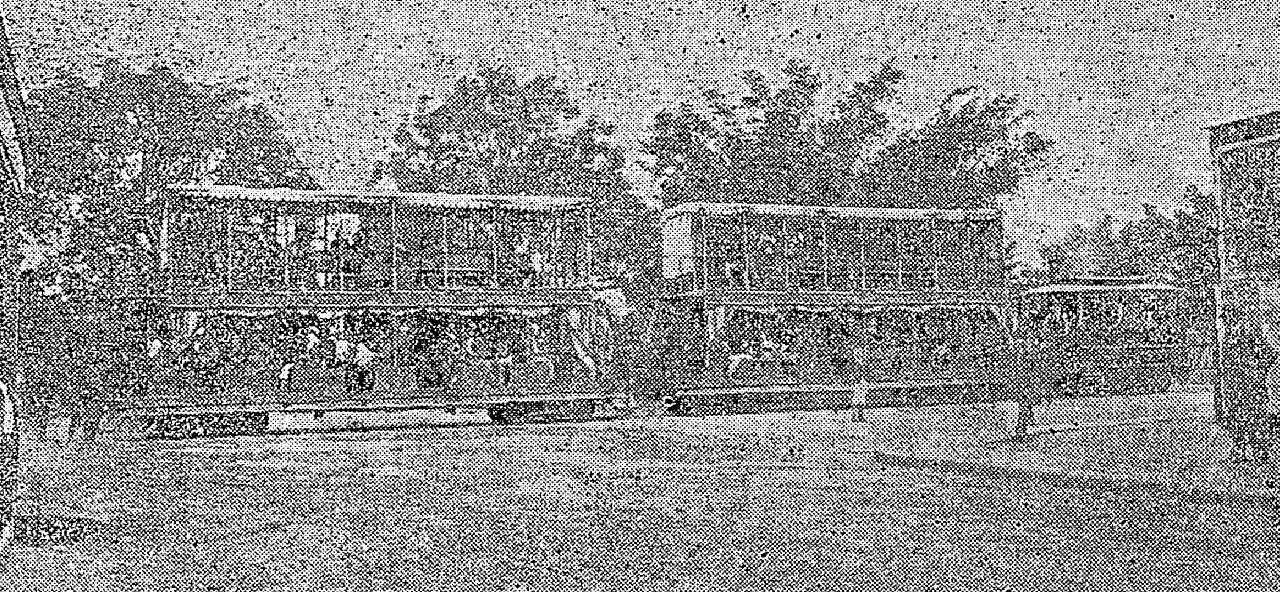
ONE OF THE OLD STEAM 'DOUBLE-DECKERS.'
THE SYDNEY TRAMWAYS. (1905, April 9). Sunday Times (Sydney, NSW : 1895 - 1930), p. 2 (Magazine Section.). Retrieved from http://nla.gov.au/nla.news-article125863156
The original of above image:
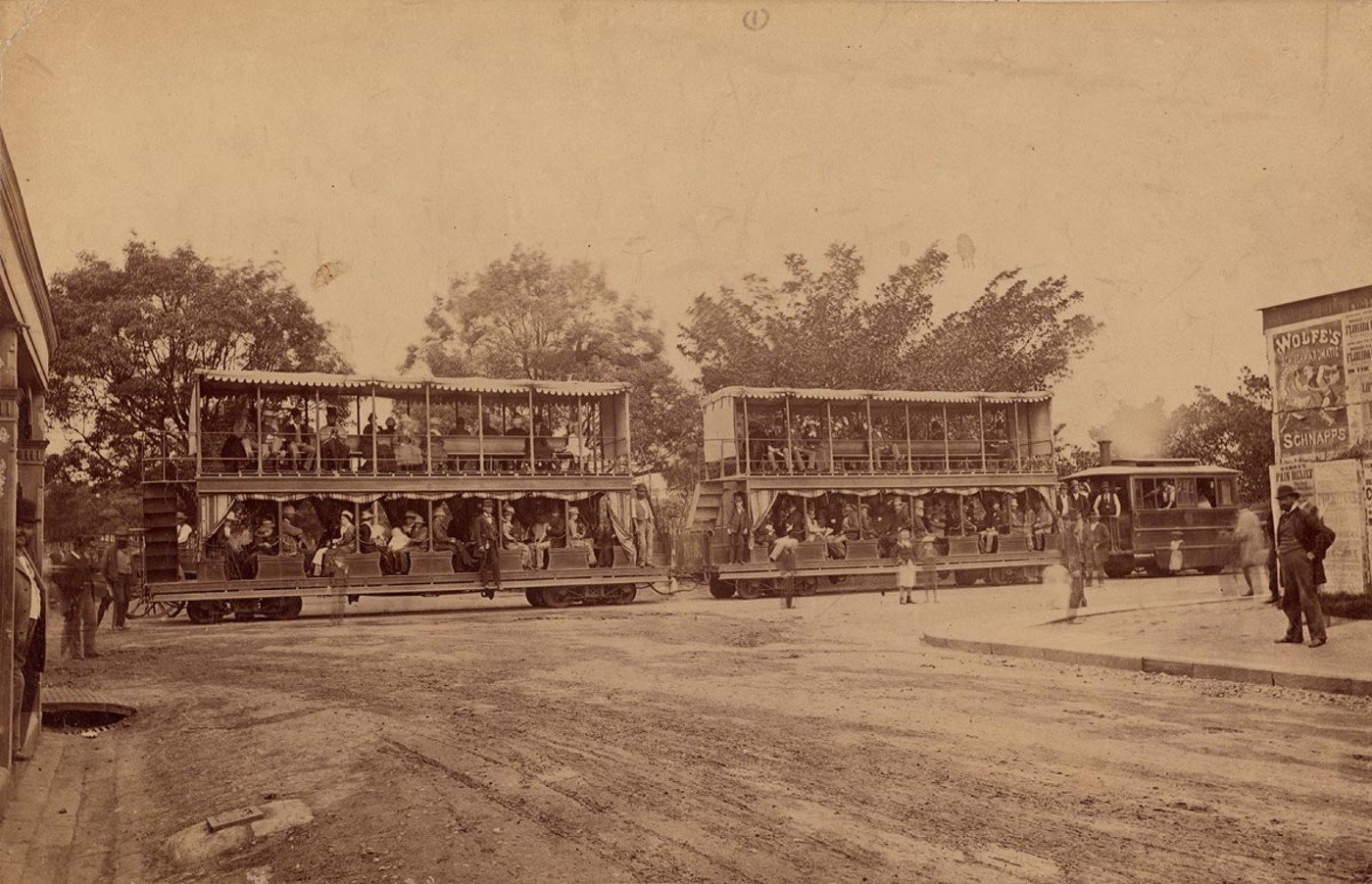
Motor and double-deck cars, Market Street, 1879, Image No.: a089340h, courtesy the State Library of New South Wales.
LEGISLATORS IN MANLY
Quarantine Station as a Park Site
TRAM EXTENSION TO PITT- WATER
At the invitation of the Mayor (Mr. Bonner), acting on behalf of a committee of prominent citizens of Manly and Warringah shire, a goodly number of members of both Houses of the State Legislature, together with several Federal - Ms.P.', made a' tour of Manly and district this afternoon. The members were met at the Spit about noon, and conveyed by motor-car to Manly, over the route of the proposed tram extension.
They were, then driven to the Quarantine Ground, where a picnic had been arranged.
Few people are acquainted with this magnificent headland, with its superb view of the harbor, and the enthusiasm with which the large crowd that foregathered there today discussed the suggestion that it should be converted Into a national park was in itself an; evidence that the public deprivation has lasted long enough. Leaving North Head, after a very .enjoyable dinner, the guests resumed their seats in the motor ears, and were taken to the ' Freshwater Lagoon. They were shown all the country In the vicinity, and such matters as that of the present imperfect drainage and the need of a bridge' were discussed.
The drive was continued to Brookvale and Narrabeen, afternoon tea being provided at the last mentioned place. The party returned to Manly, and en route discussed the possibilities of tramway extension from Curt Curl to Pittwater and Narrabeen. In the evening a social was given by Dr. Arthur, and was largely attended.
At the luncheon in the Quarantine Grounds the Mayor of Manly (Alderman Bonner) presided. Mr. IT. >S. Badgery gave the toast of "The Commonwealth and State Parliaments," and in doing so urged the legislators to give earnest consideration to the scheme for converting that splendid headland into a national park. Such a park would, he said, be unrivalled in any city in the world. Mr. Mark Mitchell supported the toast, which was heartily drunk:
Mr. Wm. Hughes, M.P., in reply, said Manly was the best watering place, certainly in all Australia, probably in the world. (Cheers.)
He had visited Llandudno, in Wales, Brighton, in England, Boulogne and Calais in France, and other famous seaside resorts, but not one of them came "any way near to Manly for bathing, climatic conditions, or anything else. He was an ardent advocate of the tramway extensions, and would connect Manly, with outlying beauty-spots, and so add to the facilities for pleasure that Sydney offered the masses of the people. He was pleased at the determination of the citizens to make the present Quarantine Grounds a people's park. From the headland they had What was perhaps the most extended, varied, and beautiful view in all New South Wales. Mr. JD. Storey, M.L.A., who also replied, remarked that the time would come when Sydney would have a population as great as that "of New York or London, and It was therefore of the utmost Importance that all the available grounds should be dedicated for recreation purposes.
Mr. H. Henley, M.L. A., proposed the toast of the district. In speaking to the toast, Mr. Fallick, M.L.A., pointed out that Manly was becoming more and more to Sydney what Blackpool was to Liverpool, and Brighton to London, the great pleasure resort. He believed such pressure would be brought to hear on Parliament to secure the Quarantine Grounds for a park that Parliament would not dare thwart the desire of the people. Mr. J. L. Farleagh. M.L.C., also supported the toast: while Mr. Arthur Griffith, M.L.A., expressed the opinion that the site upon which they were gathered would-, if dedicated as a park, be the mast useful and accessible of all the Sydney recreation grounds! He emphasised the Importance of the proposal, not only because it was Important to Sydney, but in the Interests of New South Wales.
Alderman E. M. Clark, M.L.A., was equally favorable to the scheme. Dr. Arthur, M.L.A., who responded, emphasised the point already referred to by several speakers, that Manly, was becoming more and more the holiday tow.n of New South Wales. They hoped to have 400 acres reserved for park purposes. They also hoped to greatly improve the communication by boat and tram between Manly and all the surrounding districts. With the extension of the tram to Pittwater they would obtain the finest coastal drive in Australia. The Mayor followed Dr. Arthur, and emphasised the growing importance of Manly and North Shore. Other speakers were Councillor Ralston (president of the Warringah Shire), Dr. Thomas, and Mr. F. J. Donovan.
At Narrabeen a very enjoyable tea at Dr. Pope's was followed by more speechmaking, in which Mr. Stuart Robertson, Dr. Arthur, Mr. Gordon (president of the Narrabeen Progress Society), Mr. Duffy (president of the Mona Vale Progress Association), Mr. Holden, and Mr. Hughes, M.P., took part, Mr. A. Ralston was in the chair. The day's proceedings were .throughout highly successful, notwithstanding a slight rainfall, and Manly is hopeful that big legislative grants will be the upshot of the function. - Sunday Sun (Sydney, NSW : 1903 - 1910), Sunday 18 October 1908, page 1
DOES THIS EXPLAIN THE RUMORS?

The photograph shown Minister Griffith (in the white trousers) attending a land sale at Narrabeen during the last Christmas holidays. He has just alighted from the Government motor car, seen in the background. Probably it was the Minister's presence on that occasion, and the fact that he bought some land, that led to the rumours that have persistently been circulated with respect to "his personal interest in the Narrabeen tram extension." Mr. Griffith's residence at Manly is shown on page 9.
DOES THIS EXPLAIN THE RUMORS? (1912, August 6). Construction : Weekly Supplement to Building (Sydney, NSW : 1909 - 1914), p. 8. Retrieved from http://nla.gov.au/nla.news-article234759344
"A DAY-LABOR JOB."

The Residence of the Hon. Arthur Griffith at Manly.
This photograph was taken when the house was in course of construction under the Minister's pet day-labor system. Mr. Griffith has at various times loudly chortled as to the money-saving advantages of day labor, and its efficiency. It would be interesting to know whether the Minister found that so in his own ease, or whether the system not only accounted for extra expenditure above that originally estimated, and bad construction into the bargain. "A DAY-LABOR JOB." (1912, August 6). Construction : Weekly Supplement to Building (Sydney, NSW : 1909 - 1914), p. 9. Retrieved from http://nla.gov.au/nla.news-article234759345
The opening of the tram lines to Narrabeen did increase the value of land in the area of course, anytime better access is provided to a place that accessibility will increase visitors and interest and land values. One Subdivision poster even has a tram as part of its artwork:
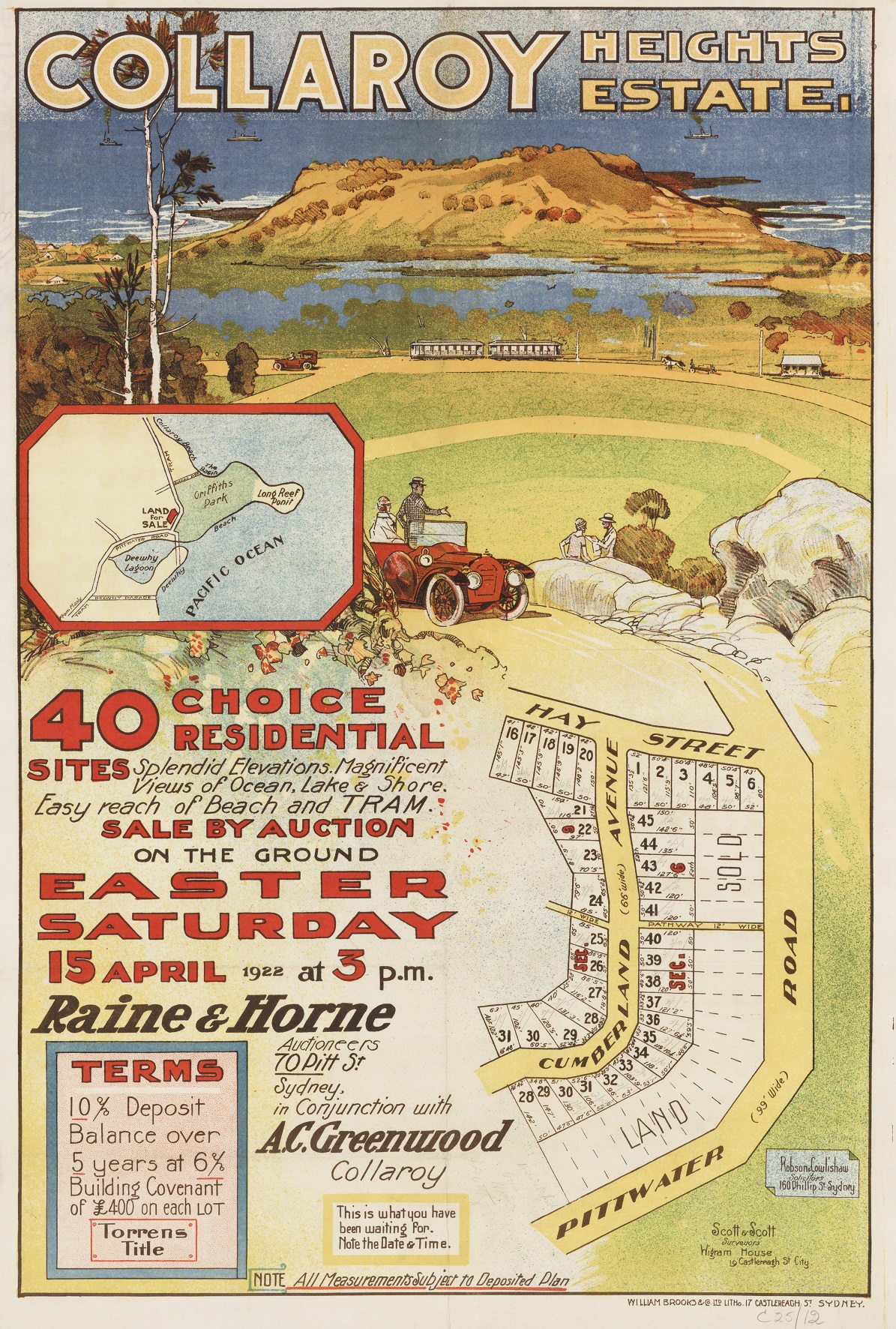
Collaroy Heights Estate, Item no. c041070017, from Collaroy subdivision plans, courtesy State Library of New South Wales
OUR NEW MEMBERS. MR. ARTHUR GRIFFITH, M.P.
Mr. Arthur Griffith, the newly-elected member for Waratah, is a young man, being only 31 years of age. HE is the son of the late Mr. Arthur Griffith, of "Gortmore Hall," Westmeath, Ireland, who came out to and settled in Victoria 20 years ago, and dying shortly afterwards left his family penniless to struggle with the world, all his means having been swamped by the failure of an Irish bank. At 16 years of age Mr. Griffith, M.P., matriculated at the Melbourne University, and subsequently put in some time at the Sydney University, but did not take a degree, preferring to go to the bar by the less expensive avenue of the Supreme Court examination. This, we understand, is still his intention. At the age of 21 he was appointed to a mastership in the Sydney Grammar School, which position he held till the commencement of the present year, when he was invited by the propaganda committee of the Labour Electoral League to seek the support of the Waratah branch with the view of opposing Mr. Melville. To this request he acceded, and was successful in performing the task set him.
During the nine years Mr. Griffith was at the Grammar School he could not, of course, take any open part in polities, but he has always been a keen democrat and a contributor to the democratic press.
Socially, Mr. Griffith belongs to a strong Tory family, the late Sir Richard Griffith, the baronet and author of the famous " Griffith's Valuation" of Ireland, being his father's eldest brother, and Sir Hercules Robinson, at one time Governor of New South Wales, being his first cousin, so that the present Labour member's bitter radicalism is not an inherited attribute but a result of his own observation of our social and industrial conditions. He is a strong Protectionist, but threw in his lot with the Labour party on account of his dislike to the alleged anti-democratic tendencies of the Dibbs Ministry. To quote his own words, he considers the Labour platform is "the only solid ground on which a conscientious democrat can take his stand amid a wilderness of shifting creeds and warring factions."
Mr. Griffith is well known in athletic circles in Sydney and Melbourne. He won the amateur boxing championship in Melbourne some years ago, and last year carried off the amateur swimming championship at Manly. He has also been presented with the National Shipwreck Association's medal for swimming through the ocean surf and rescuing at the risk of his life a gentleman who had been carried off by the current. During the past three years Mr. Griffith has held the position of honorary secretary of the N.S.W. Lawn Tennis Association. Our picture shows him in the uniform of an officer of the Sydney Grammar School cadet corps.
OUR NEW MEMBERS. (1894, July 25). Newcastle Morning Herald and Miners' Advocate (NSW : 1876 - 1954), p. 5. Retrieved from http://nla.gov.au/nla.news-article133201479
Members of the New State Legislative Assembly—No. V.
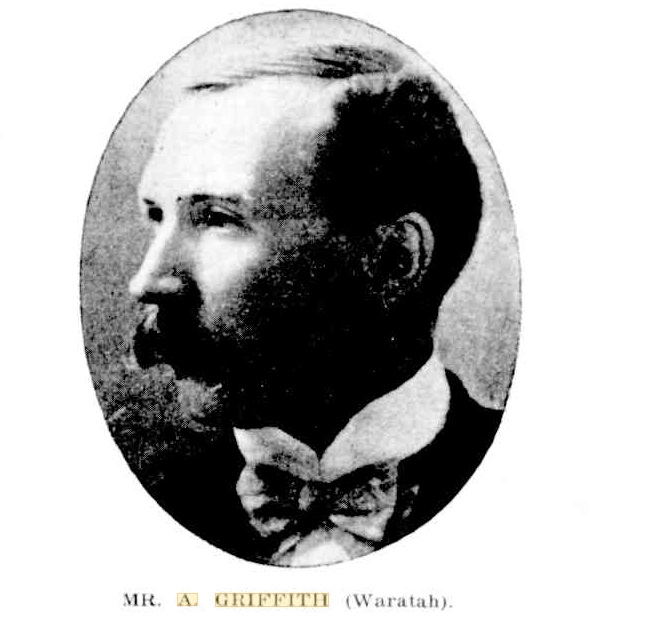
MR. A. GRIFFITH (Waratah).
Members of the New State Legislative Assembly—No. V. (1901, August 24). Australian Town and Country Journal (Sydney, NSW : 1870 - 1907), p. 24. Retrieved from http://nla.gov.au/nla.news-article71471376
DEATH AT MANLY
Mrs. Arthur Griffith
SYDNEY, Thursday.
Mrs. Arthur Griffith died this morning at her residence, 'Earlscourt,' Manly. She had been suffering for some time from Bright's disease and a heart weakness. Mrs. Griffith was a daughter of the late Mr. William Smith, police magistrate, of Maitland, and sister of Mrs. A. J. Akhurst (mother of Miss Daphne Akhurst), of Ashfield. The funeral will take place at Manly at 2.30 p.m. to-morrow. DEATH AT MANLY (1926, October 21). The Newcastle Sun (NSW : 1918 - 1954), p. 7. Retrieved from http://nla.gov.au/nla.news-article163594961
THE PREMIER'S HAPPY FAMILY.
CHAT WITH Mrs. McGOWEN-A MESSAGE TO ' SUNDAY TIMES ' READERS.
The world knows the movements of the modern -politicise; the world reads his utterances day by day, but little, indeed, do the people hear of the family ties, the inner life of men who control our political destinies. The Premier of New South Wales is no exception to the rule. and-*t i» of interest to peep behind the scenes, to chat with the mate of his fortunes, the one who, through goad or ill, has braved the battle by his side and now tends to his material wants in the stress of the fight and the worries of State control. A 'Sunday Times' representative, found the I Premier's home in Pitt-street, Redfern, a pleasant, simple suburban, house, with no outward sign to impress the world 'that here lived James T. McGowen, Premier of New South Wales.'
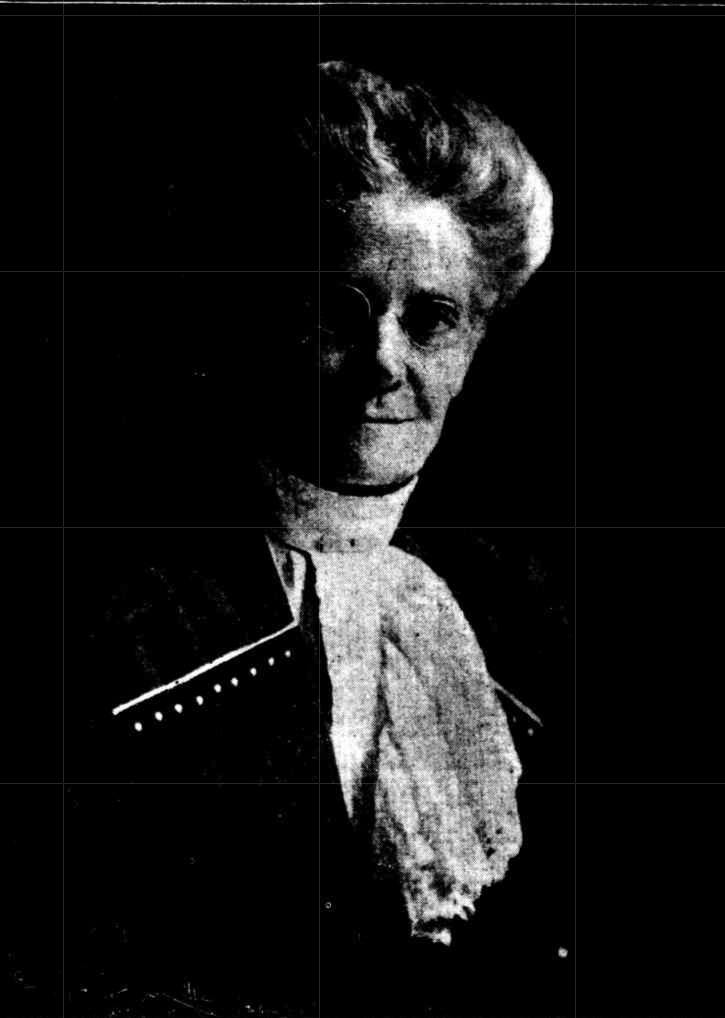
MRS. J. S. T. MCGOWEN.
If the fortunes of our Premier have gone high, he apparently has no desire to challenge ,the world with display. His house expresses hiss frugality, the rugged kindliness of the blunt champion of the people and the proud father of eight happy boys and girls. 'Sit down,' said Miss McGowen, 'and I'll fetch mother.'
In the interval the visitor had time to absorb the air of home, the sense of benevolent control, and to mark in his look THE TROPHIES OF HIGH OFFICE, spades, mallets, shovels, which told of the laying of many foundation-stones. On the walls were addresses of ''admiring and loyal' supporters. These were interspersed with photos, of the family, frank-looking, manly boys, and pleasant girls.
'Good morning,' said a pleasant-voiced little lady, entering the room and giving the visitor a hearty hand clasp. ' It was Mrs. McGowen:
Getting ready for.Christmas, Mrs. McGowen ? 'Yes; can't you hear the noise of my big, bouncing boys ? ' she said, referring to the rollicking youths who were having the time of their lives in the other rooms. And everything is ready ? 'Quite. Jim will be so happy with the boys round him. And then it's my birthday, so we shall have a jolly time. But my husband doesn't live to eat, he eats to live. Plain living and high thinking appear to be the rules of his life. And he's so easy-going. Nothing worries him. Just staid and stolid'. They say he's slow, but I think.it better to be slow arid sure don't you. I'm just the reverse, and often tell him I do the worrying. It makes me so nervey this.public life. However, I feel better after my holidays.' .
How do you like Government House functions ?' 'I've got used to them. And Lady Chelmsford is so sweet and nice. I just sit down and tell her all my troubles. We're just good friends. She was so helpful to me before I went to the Coronation in England.' Did you enjoy that ? : 'It was a dream from start to finish. I was BUBBLING WITH PLEASURE AND EXCITEMENT all the time. Before I went they frightened me with all sorts of stories about etiquette, snobbery, and having a maid, and all those silly things. Indeed, I once said I wouldn't go. But Jim wouldn't go without me.' Tell me about the Court. 'Oh,.. it was fine. Beautiful women, and such pretty dresses. And how kind they wero to me. They dressed me so nicely, and Miss Coghlan and I went together. V,'e just marched past the King and Queen and made our bows. She is' such a sweet, good woman, and so homely and motherly with her children. We all loved her. With such a Queen the nation's women .lave a fine example.' How did Mr. McGowen look in his Court dress ? '?Just splendid. He's so big and strong. I wish, he would wear it oftener. Lord Chemnsford thinks he looks so well in it.' How did the Old Country impress you ? ? 'Well, I saw little of the shade, or darker side. I was in the sun. Everything was so delightfully new, be pleasant. I left Australia with many prejudices about England and its people. I came back with such a different view. We're just one big family, and we shouldn't find time to growl. I got a fright when I was there. Mr. Holliman, the Secretary of the Treasury, came to us one day and said the Government had been knocked out, and that Jim was Premier no more. 'Don't worry,' said Jim, 'life's too short. Everything will come right.' And it did. Mr. Wade couldn't form his Ministry, and so we came back to Australia as we went.' What did your friends say after the trip ? ? ' 'You Jiaven't changed. We thought you would have been such a grand lady, and wouldn't talk to us after that.' they said to me. But I just told them that I had lived too long to become vain and silly. And there's no happiness in being snobbish. I find enough to be proud of in my big, strong boys and girls. Goodness and mercy have followed me all the days of my life. What more do we want than that. Goodbye, and a Happy New Year' to you.'.
THE PREMIER'S HAPPY FAMILY. (1912, December 29). Sunday Times (Sydney, NSW : 1895 - 1930), p. 25. Retrieved from http://nla.gov.au/nla.news-article120671267

King Street, Sydney circa 1900 1910 a116380h, courtesy State Library of NSW
